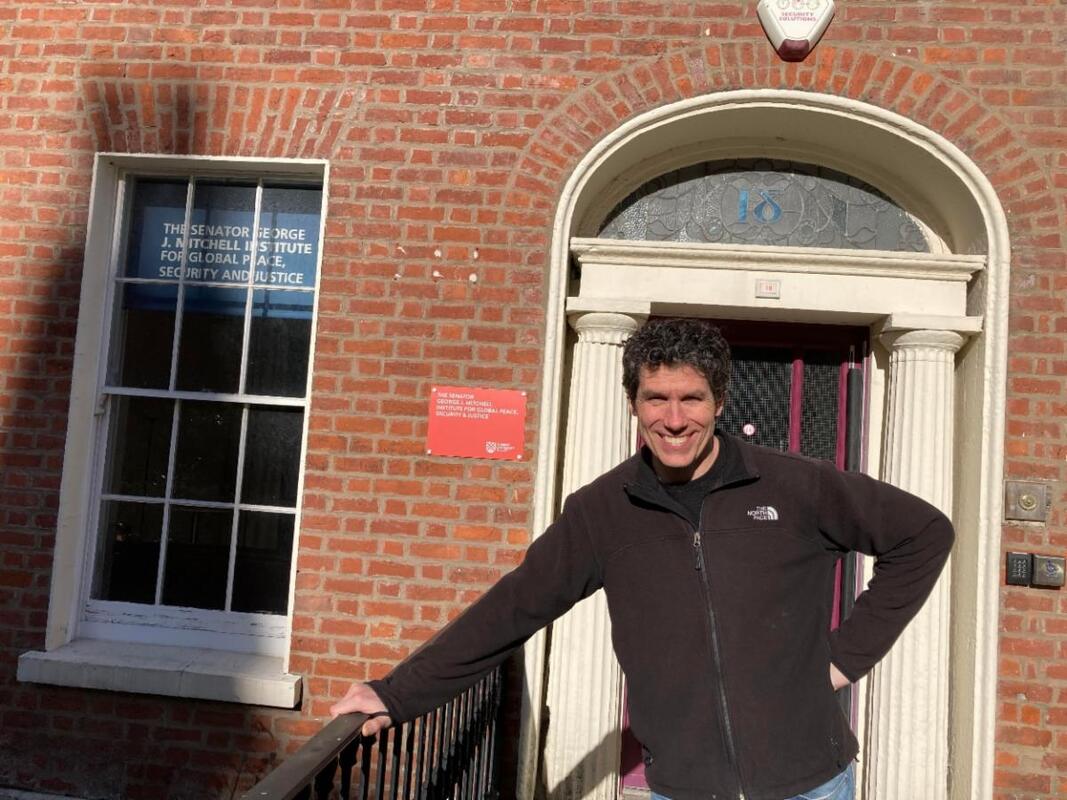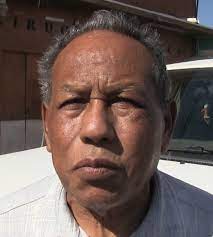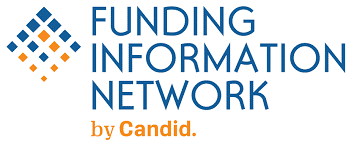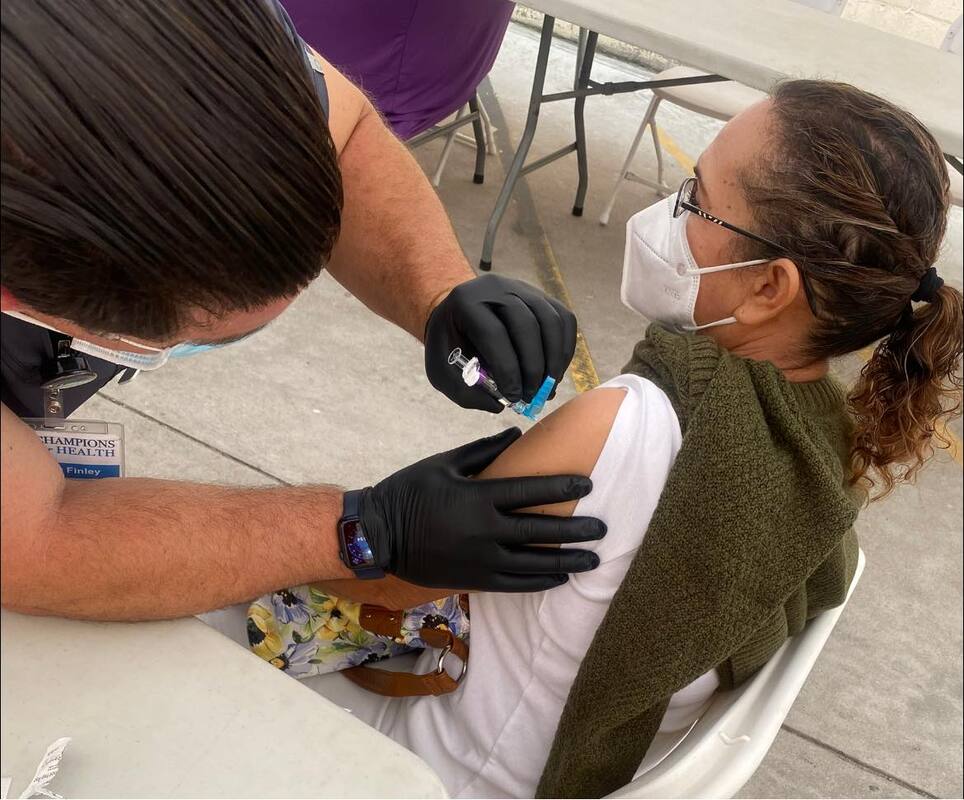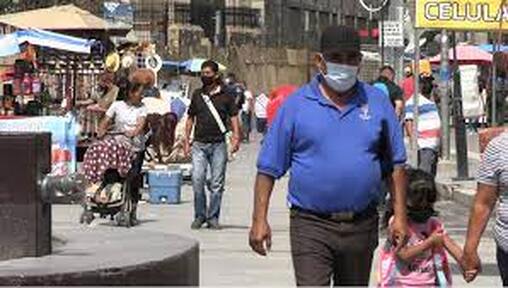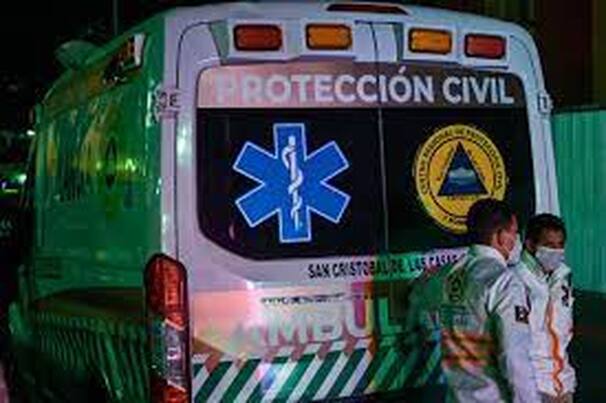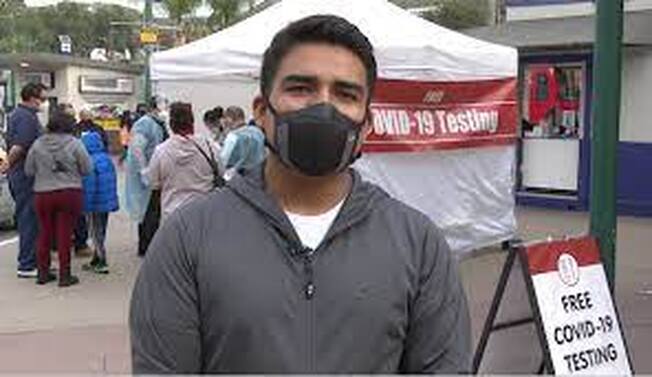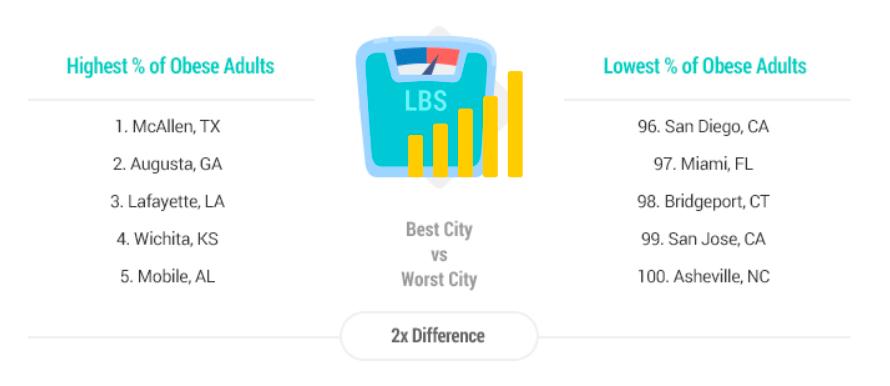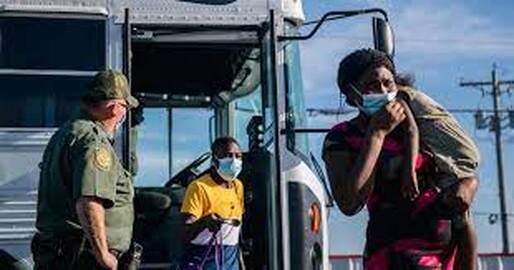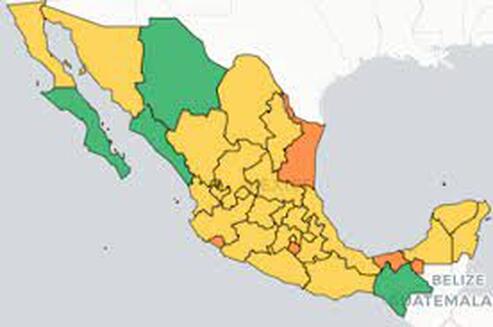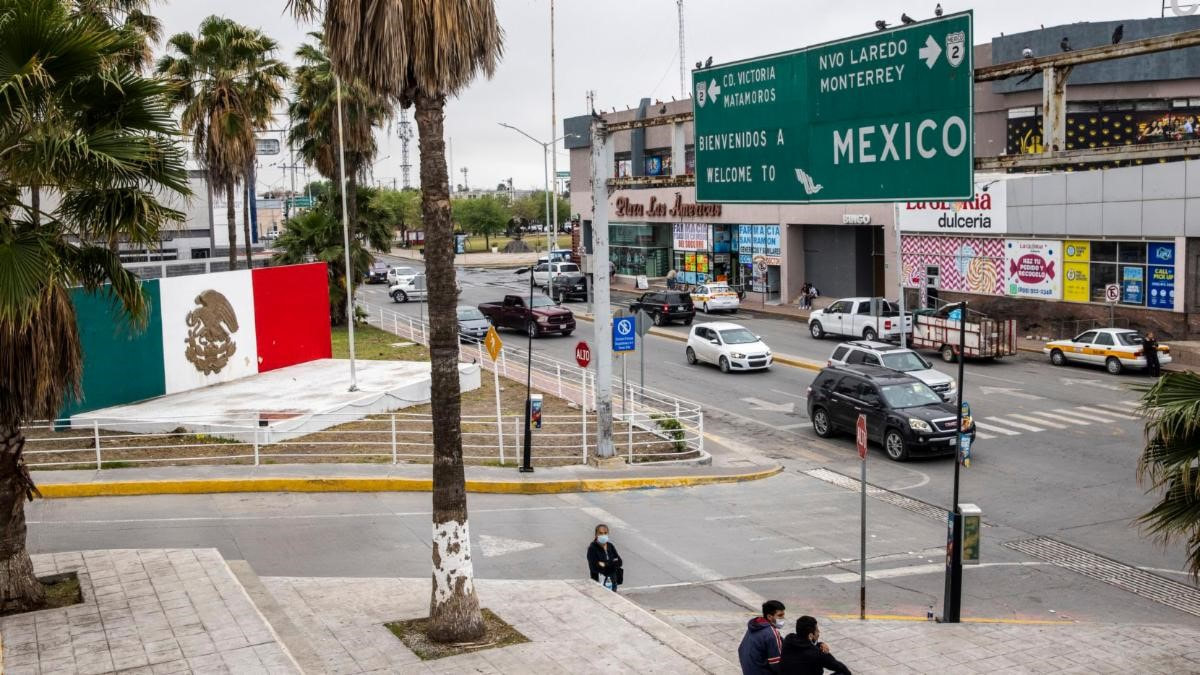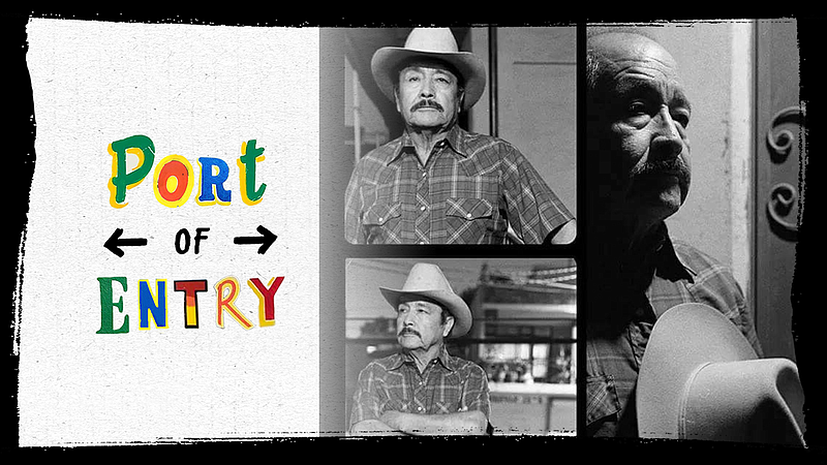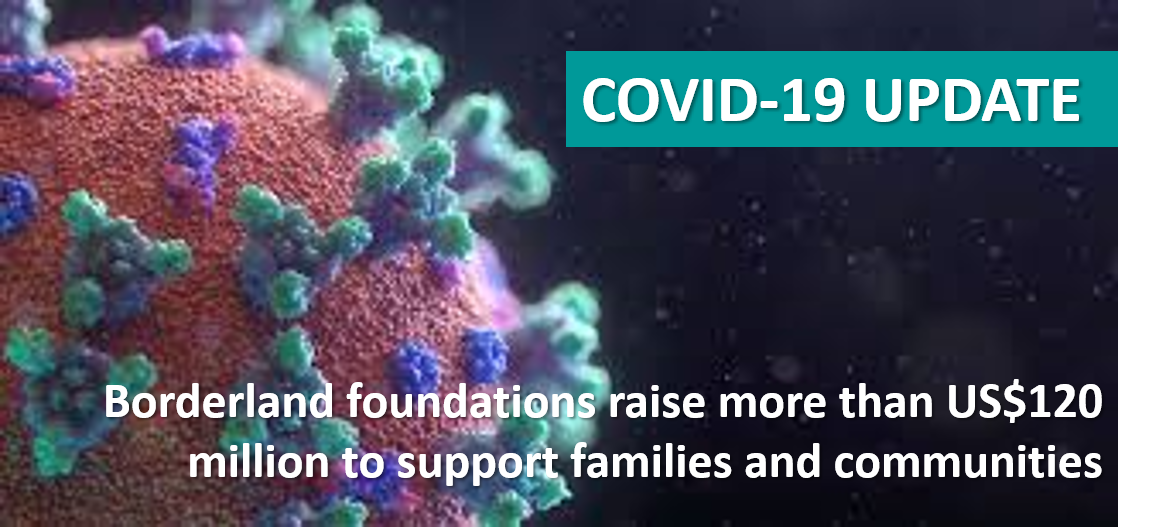COVID-19 at the Border
San Ysidro parents demand school district make board meetings more accessible. Livestreaming public meetings has become standard practice for many agencies — but not at the San Ysidro School District. Now, parents are calling on leaders to increase access to school business. Though state law does not generally require agencies to livestream meetings, it has become increasingly common since the COVID-19 pandemic forced agencies to shut down in-person operations. That includes the San Ysidro district, which continued to meet remotely and livestream through 2022. But since the district returned to in-person meetings, livestreaming has been sparse and only available when one of its board members attends remotely. The last recorded meeting on the... (read more)
May, 2024
Closure of US-Mexico border during Covid pandemic increased HIV transmission. Leer en español. Efforts by U.S. authorities to prevent the spread of one virus encouraged the spread of the other, according to a study in ‘The Lancet.’ The border crossing that separates Tijuana in Mexico from San Diego in the United States is one of the busiest routes in the world for drug trafficking and migration. It is a dynamic human corridor shaped by deportations, inequality, prostitution and marginalization that the authorities decided to close in 2020 to contain infections from one side to the other when the Covid-19 pandemic broke out. But the closure did not stop drug tourism between the two countries. And instead of preventing the spread of disease, the authorities’ strategy led to an increase in HIV transmission, according to a study recently published in the journal The Lancet. The research was a collaborative project between American scientists from the University of California in San Diego and Irvine that analyzed the... (read more)
February 7, 2024
Understanding the Role of Immigrants in the US Health Sector: Employment Trends From 2007–21. Health care professionals were widely praised for their work on the front lines of the COVID-19 pandemic. But the U.S. health care sector faces longstanding challenges that undermine its capacity to respond to future health threats and provide critical care. These challenges include an aging population, worker shortages, and the underrepresentation of minorities, a problem that has important implications for health care delivery. Meanwhile, policymakers have the difficult task of simultaneously expanding health care access, improving health care quality, and reducing costs without compromising compassionate care. Immigrants and the U.S. immigration system offer a potential solution to... (read more)
TAMIU Ballet Folklórico students travel to France, first to perform at Disneyland Paris. A total of 20 Texas A&M International University (TAMIU) Ballet Folklórico students recently returned from a performance in France upon an invitation extended by Disneyland Paris. Their performance marked the first-ever Mexican Folkloric Dance Group performance there. This was the group's first time performing at Disneyland Paris, located in Chessy, near Paris. Students performed a 20-minute show titled, "México en la Piel, Alma y Corazón," choreographed by TAMIU Ballet Folklórico instructor Nayeli López. “We have been wanting to perform for Disneyland Paris for many years now," López said, "We initially got invited for December 2020, but due to the COVID Pandemic, the trip was put on hold for the future. We finally got invited again, and this time it was going to happen." Students put in a lot of their time, effort, and... (read more)
November 2, 2023
Pima County rental assistance funds running out. Pima County is winding down a program that provided almost $89 million to help some 17,000 households make rent and utility payments. It started in 2021 during the COVID-19 pandemic.
September 8, 2023
INTRIVO Diagnostics, Inc. gives 17,000 COVID tests to BPP for use in Ventanillas de Salud. The U.S.-Mexico Border Philanthropy Partnership is pleased to announce that INTRIVO Diagnostics, Inc., a Miami, Florida based healthcare company has presented 17,000 COVID-19 tests for distribution to the public through the Ventanilla de Salud program at Mexican Consulates located in the U.S.A. The Ventanilla programs were all offered the opportunity, and 14 located across the country agreed to participate. Each Health and Wellness program is to receive between 1,000-2,000 test kits. “We are elated to continue to support COVID-19 programming”, says Andy Carey, Executive Director. “Our community was one of the most impacted, and we look forward to supporting this important effort through the end of January 2024.” Intrivo Co-CEO and Co-Founder Ron Gutman added: “One of our core values in On/Go for Good by Intrivo is providing those in need with immediate access to high quality healthcare anytime anywhere. I deeply believe that healthcare is a fundamental human right and our collaboration with and donation to the U.S.-Mexico Border Philanthropy Partnership exemplifies our commitment to helping everyone live healthier happier lives and aligns perfectly with our core values.” The in-kind value of the COVID-19 tests exceeds US$140,000.
COVID-19 spike in Baja prompts vaccination drive for children. Health leaders in Baja California have announced a plan to immunize children between the ages of 5 and 11 as the state has seen COVID-19 cases spike in recent weeks. Secretary of Health Adrián Medina Amarillas says 10,000 doses of the Pfizer pediatric vaccination are set to arrive in Baja any day, and that 3,000 are already being administered at public places such as schools. “Children are considered a smaller risk, but we need to make sure they are protected,” he said. Medina Amarillas decided on vaccinating children after detecting a rise in overall documented cases and “a lag in the... (read more)
July 12, 2023
U.S.-Mexico border covid-19 testing program ends. The U.S.-Mexico Border Philanthropy Partnership (BPP), the Consulate General of Mexico in San Diego, the California Department of Public Health (CDPH), and Cross Border Xpress (CBX) announce the end of the U.S.-Mexico Border COVID-19 Testing Program at the San Diego-Tijuana CBX on June 29, 2023. Beginning on April 25, 2022, international travelers entering San Diego through the CBX terminal from the Tijuana Airport were able to take voluntary COVID-19 tests thanks to this dynamic public-private-philanthropic partnership among BPP, the Consulate General of Mexico in San Diego’s Ventanilla de Salud Program, the CDPH, and CBX. A total of 16,857 individuals, aged 5 and up, participated in the program, and 564 positive COVID-19 cases were identified. “This program helped to prevent the spread of COVID-19 to our binational friends and families while traveling internationally, and we thank the Consulate of Mexico in San Diego, the State of California, and CBX for rising to the challenge of COVID-19 with this innovative program,” said Andy Carey, Executive Director of the BPP.“ Funded by the CDPH’s California Office of Binational Border Health, the program allowed the CDPH COVID-19 Testing Task Force to test for COVID-19 and to provide international travelers with information about prevention and treatment.
April 26, 2023
COVID-19 testing at Cross Border Express terminal reaches more than 14,748 travelers. Since April 2022, the U.S.-Mexico Border Philanthropy Partnership, the Ventanilla de Salud San Diego, the Consulate General of Mexico in San Diego, Cross Border Express, and the California Department of Public Health have partnered to provide travelers entering the United States from Mexico via the Cross Border Express access to free COVID-19 tests. "As of this week, the number of volunteer participants has reached nearly 15,000 individuals," says BPP Executive Director Andy Carey. "This program is so important as it provides peace of mind for families and communities so we can all remain healthy and free of COVID-19," adds Carey. The program is part of a three port of entry initiative spearheaded by the Department of Public Health. San Francisco International airport, Los Angeles International airport, and Cross Border Express are all participating. Individuals are provided confidential results and can complete the tests onsite or at home. The program continues until June 30, 2023.
Apirl 12, 2o23
How important is Juarez to El Paso's economy? The economic future looks bright for the Borderland and a big reason why is our location on the border. University of Texas at El Paso Economist Dr. Tom Fullerton told CBS4's John Purvis, "There's going to be continued investment in factory capacity all around Ciudad Juarez." With a population of 1.5 million people, Juarez is seeing an economic boom thanks to one of the major consequences of the COVID-19 pandemic. American companies want to move their manufacturing away from Asia and bring it much closer to home which has led to major growth in maquila plants across the Juarez area. UTEP's Hunt Institute reports that Juarez gained 19,000 jobs last year compared to less than 6,000 in El Paso and 3,500 in... (read more)
March 22, 2023
Latino families in US without legal permission suffered more than most during pandemic, study finds. The COVID-19 pandemic caused a disproportionate amount of illness and death among Latino families lacking permanent legal status compared with the general U.S. population — and factors such as poverty, dangerous living conditions and lack of access to health care are to blame — according to a new study from Rice University. “Implications of Undocumented Status for Latino Families During the COVID-19 Pandemic: A Call to Action ” was published recently in the Journal of Clinical Child and Adolescent Psychology. The study assessed the opinions of families residing in South Texas, near the U.S.-Mexico border. The researchers, who conducted a series of... (read more)
February 22, 2023
California says it can no longer afford aid for covid testing, vaccinations for migrants. All day and sometimes into the night, buses and vans pull up to three state-funded medical screening centers near California’s southern border with Mexico. Federal immigration officers unload migrants predominantly from Brazil, Cuba, Colombia, and Peru, most of whom await asylum hearings in the United States. Once inside, coordinators say, migrants are given face masks to guard against the spread of infectious diseases, along with water and food. Medical providers test them for the coronavirus, offer them vaccines, and isolate those who test positive for the virus. Asylum-seekers are treated for injuries they may have suffered during their journey and... (read more)
February 9, 2023
Medical and ‘consular’ tourism picks up in Juarez. Dental offices, bariatric surgeons hope to maintain momentum despite perception of violence abroad. Jose Luis Rodriguez has done the math and whenever he needs to take care of a minor health ailment, he crosses the border into Juarez rather than request an appointment with his doctor in the U.S. “If you feel ill, of course, you come here because it is cheaper. Over there, the appointment will end up running you upwards of $100. Here, you pay 500 pesos (U.S. $26),” the Socorro, Texas, resident said. Medical tourism is up in Juarez after a couple of slim years brought about by the COVID-19 pandemic. Dental offices, general medicine practitioners and some specialty surgeons are the ones benefiting the most. “The services more in demand are dental, because they are more... (read more)
January 25, 2023
Bipartisan U.S.-Mexico Tourism Improvement Act. The bipartisan legislation will help rebuild the tourism industry. Congressman Henry Cuellar (D-TX-28) and Congressman Michael McCaul (R-TX-10) introduced the bipartisan United States-Mexico Tourism Improvement Act. This legislation will increase governmental cooperation between the United States and Mexico to reinvigorate tourism in both countries in response to disruptions caused by COVID-19. “The United States is the primary destination for Mexican travelers,” said Congressman Cuellar. “Tourism between our two countries is a critical economic driver for our state’s economy, especially in South Texas. The United States-Mexico Tourism Improvement Act will build a more resilient tourism economy post COVID-19 by bolstering tourism between our two countries and strengthening our relationship with our... (read more)
3 years later: How cross-border partnership helped El Paso, Juárez manage COVID. Three years later, Dr. Sophia Selene Torres Valdez still vividly remembers how the vaccine shortage devastated Ciudad Juárez at the peak of the COVID-19 pandemic. Inside the Juárez public hospital where she worked in 2020, COVID patients were being treated in chairs lining the emergency room’s corridors. Whole families were entering hospitals as patients. Bodies were piling up in morgues. “It was like what you saw in the news happening in Europe,” said Torres, director of medical units for Federacion Mexicana de Asociaciones Privadas (FEMAP). “It was happening the same way in Juárez. We were overwhelmed. As a doctor, we would see the worker, his sisters, his wife, and his parents and they would all die.” Meanwhile, just a few miles across the border in El Paso, vaccine doses were expiring and... (read more)
Explainer: Why migrants are crossing the U.S.-Mexico border in record numbers. What is happening at the U.S.-Mexico border now and why are there record numbers of crossings? U.S. Border Patrol made more than 2.2 million arrests at the U.S.-Mexico in the 2022 fiscal year, which ended last September, the most ever recorded. But many of those were individual migrants who tried to cross multiple times after being caught and rapidly expelled back to Mexico under a COVID-era order known as Title 42. The policy was implemented in March 2020 under Republican former President Donald Trump, an immigration hardliner. Biden, a Democrat, tried to end the Title 42 order, which health officials said was no longer needed, but the... (read more)
January 4, 2023
Ventanilla de Salud COVID-19 program reaches 750,599 individuals, Laredo, TX reaches largest population. Since July 1, 2021, BPP has supported the 51 Ventanilla de Salud programs across the United States in an ambitious program to vaccinate the undocumented, Latino, and Hispanic community against COVID-19. In collaboration with the Institute for Mexicans Living Abroad, the Mexican Consulate General network across the country, the Mexican Embassy, and a network of nonprofit partner organizations, we have successfully reached 750,599. This is the first time this network has collaborated on such an ambitious project, says BPP Director Andy Carey. Together, we have saved hundreds of thousands of lives and protected our families and community from this pandemic. The health and wellness outreach included over 3,000 health fairs and vaccination clinics, financial support for healthcare workers, securing PPE, and more. Each Consulate and their Ventanilla de Salud program participated and did a terrific job. Laredo, TX reported the most individuals vaccinated at over 250,000. This program was possible thanks to the financial support of the David & Lucile Packard Foundation, the Mexican Ministry of Public Health, the Mexican Foreign Ministry, the Institute for Mexicans Living Abroad, all the agencies supporting the Ventanilla de Salud program across the United States, and the Border Philanthropy Partnership.
America needs immigrants to solve its labor shortage. Immigration has long been a political football in the United States. But if you’re wondering why America’s labor shortage persists nearly three years into the Covid pandemic, it’s in part because America doesn’t have enough immigrants. Immigrants are vital to the US economy and fill thousands of US jobs – jobs many Americas don’t want to do. In 2020, the processing of legal immigrant worker visas stopped and only picked up towards the end of 2021. And by the end of last year there were close to 2 million fewer working-age immigrants in the United States than there would have been if pre-pandemic immigration continued unchanged, according to new research from the University of California, Davis. “Part of the reason why there are so many vacancies and unfilled jobs in the US is that we are missing a whole lot of... (read more)
LA Times Editorial: Two misconceptions and a truth about the U.S.-Mexico border. The myths — or, rather, convenient lies — that some politicians keep circulating about the U.S.-Mexico border have resulted in another disappointing congressional session for immigration reform. Instead of crafting much-needed solutions to address the fate of young immigrant “Dreamers,” the backlog of cases in immigration courts or any of the myriad problems caused by outdated immigration laws, policymakers spent most of their time wrangling over Title 42, a public health order invoked during the COVID-19 pandemic to manage border crossings. Disinformation prevents policymakers from having honest discussions and enacting sensible solutions. The complex U.S.-Mexico border region is a... (read more)
Date published: November 30, 2022
BPP partners with Candid to bring Foundation Directory online to the Borderlands. The U.S.-Mexico Border Philanthropy Partnership is excited to share its new partnership with Candid. The New York City based nonprofit organization is renowned for its support of the nonprofit sector across the globe, particularly in support of resource development. During the COVID-19 pandemic, BPP and Candid completed a test program to evaluate effective delivery of Foundation Directory Online (FDO) services to the BPP member network. The test was an overwhelming success, says BPP Executive Director Andy Carey, and with the wonderful support of our donor partners, today we are pleased to launch this new and effective service to the member network. BPP is offering virtual access to the Foundation Directory Online as part of our membership services. Member organizations will be able to complete research on potential funder partners for their organization on both sides of the U.S.-Mexico Border. Additionally, BPP is placing onsite access to the Foundation Directory Online in 5 locations as part of the Funding Information Network program. The locations include: BPP offices at the San Diego Foundation in San Diego, CA; Cadenas de Ayuda para Mexico in Mexicali, Baja California; Centro de Formación Social in Hermosillo, Sonora; Fundación Paso del Norte para la Salud y el Bienestar in Juárez, Chihuahua; and Universidad de Monterrey (UDEM) in Monterrey, Nuevo León. This new partnership also includes 10 new training programs to support nonprofit organizations capacity building initiatives. The trainings will be offered and delivered virtually to the BPP member network beginning in 2023. Initial funding for the program was provided by the Jesús M. Montemayor Foundation, based in Monterrey, Mexico. For more information, please contact Ma. Laura Muñoz.
Migration, country by country, at the U.S.-Mexico border. The COVID pandemic, and related U.S. efforts to curtail access to asylum, have caused patterns of migration at the U.S.-Mexico border to fluctuate in often sharp and unpredictable ways. The two graphics below indicate the top countries of citizenship of migrants encountered at the U.S.-Mexico border in fiscal years 2020-2022 and in the past three full months (August-October). Mexico is nearly always the number-one country of origin for migrants at the U.S.-Mexico border. Until 2012, over 85 percent of migrants whom Border Patrol apprehended were citizens of Mexico. By 2019, that had fallen to 20 percent; Mexican migrants made up 33 percent in fiscal year 2022 (October 2021-September 2022), and 28
Date published: November 17, 2022
COVID testing at Cross Border Express to continue through June 2023. Border Philanthropy Partnership is excited to share that our COVID-19 testing program for in-bound travelers to Cross Border Express between the Tijuana airport and San Diego County will continue until June 2023. This is an exciting development as the number of positive cases continues to grow each day. Since April 28, 2022, BPP in collaboration with Ventanilla de Salud, Consulate General of Mexico in San Diego, California Department of Public Health, and Cross Border Express, nearly 10,000 passengers have voluntarily taken a COVID-19 test upon entering the U.S.A. This dynamic program is allowing passengers peace of mind for themselves, their families, and their community, as individuals complete international travel, says BPP Executive Director Andy Carey. We so appreciate the collaboration amongst all the partners, and most of all, the passengers, who are telling us how important this is to enable them to stay healthy. The tests are available at no charge and are distributed by the Ventanilla de Salud program here in San Diego County.
October 13, 2022
BPP Ventanilla de Salud program for COVID-19 passes 729,000 vaccinations across USA. Since last year, BPP has worked closely with the Institute for Mexicans Living Abroad, the Mexican Consulate network, the Border Health Commission, and local nonprofit organizations to support COVID-19 vaccinations for the Mexican, Latino, and undocumented community across the United States. As of October 3, 2022, it is reported we have successfully vaccinated 729,000 individuals. Our goal is to reach 1 million individuals, says BPP Executive Director Andy Carey. The collaboration amongst all the partners has truly been amazing. Our community is the most adversely impacted by COVID and we have a duty to act. Together, with the generous support of the David & Lucile Packard Foundation, we are closing in on our goal. We will continue to press the issue all the way to December. For more information contact Andy Carey.
September 29, 2022
BPP receives over 5,000 COVID tests to help asylum seekers at U.S.-Mexico Border. The U.S.-Mexico Border Philanthropy Partnership received more than 5,000 COVID-19 testing kits to help ensure the asylum seekers at the U.S.-Mexico Border are free of COVID-19. The test kits were donated by the State of California Department of Public Health. BPP is presenting the test kits to the Consulate General of Mexico in San Diego for delivery to migrant shelters in Mexico. As the Biden Administration works to lift the Title 42 restrictions, we want to ensure the asylum seekers are entering the U.S. free of COVID, says BPP Executive Director. We are honored to work with Ambassador Carlos González Gutiérrez, Consul General of Mexico in San Diego, continues Carey. The Consul General and his team are leading the way in crossing the test kits and getting them to the people most in need. This effort is part of a larger program at BPP in promoting COVID-19 vaccination and testing across the U.S.A.
August 31, 2022
U.S. donating COVID-19 vaccines to Mexico as domestic demand drops. Not far from the U.S. border, hundreds of men, women and children waited in an hours-long line in Nuevo Laredo, Mexico, for a chance to get a COVID-19 vaccine. "This line is here almost every day," Dr. Victor Treveño said. Treveño works on the other side — in Laredo, Texas — but is leading a bi-national effort to distribute donated vaccines here. "And the reason for that is we're one community and whatever affects them affects us and vice versa…we're both communities are 150 miles away from major cities so we have to tend to our needs locally," he said. So the team, with the approval of U.S. Customs and Border Protection, devised a way to bring people to a secure spot along the port of entry. The spot was chosen because... (read more)
August 17, 2022
Vaccination program across Ventanilla de Salud reaches 712,189 individuals. BPP is pleased to share that the COVID-19 vaccination program has officially reached 712,189 individuals in collaboration with the Ventanilla de Salud program at Consulates General of Mexico across the U.S.A. Since July 2021, BPP has collaborated with the Institute for Mexicans Living Aboard, the network of Consulates General of Mexico in the U.S.A., and the nonprofit community organizations that support health and wellness activities in the service area of the 51 Mexican consulates in the United States. Our goal is to reach 1 million individuals from the Hispanic, Latino, and undocumented community. This is an amazing sign of progress to achieve such a strong number, says BPP Executive Director Andy Carey. This is only possible due to the strong partnership with the Mexican government, as well as the care and concern the nonprofit community takes in serving the Spanish speaking community in our country, says Carey. Our work is not yet done. Our goal is to reach an additional 300,000 individuals before year’s end. This program is possible thanks to the grant support of the David & Lucile Packard Foundation, the Institute for Mexicans Living Abroad, Mexico’s Ministry of Public Health, and numerous individual donors, corporate foundations, and grantmaking foundations across the United States. For more information contact Andy Carey.
If you're planning to travel to Mexico, here's what you'll need to know and expect if you want to visit during the Covid-19 pandemic. The latest: The US Centers for Disease Control and Prevention has lifted its requirement for travelers to test negative for Covid-19 before entering the United States. This will ease passage back to the United States for American citizens, who constitute a big block of tourism to Mexico. The basics: Mexico remains open to travelers. There is no need to provide a negative PCR test or quarantine on arrival, though most resorts ask guests to fill out health questionnaires. What's on offer: You'll find incredible food, sensational beaches, charming towns and historical remains in Mexico. While the beach resorts around Cancun attract the bulk of visitors, those who want more than a fly and flop go for... (read more)
July 20. 2022
Juarez again to require face masks due to COVID-19 spike. Chihuahua state officials fear new wave of coronavirus infections if prevention protocols not reinstated. Faced with a surge in COVID-19 cases, the state of Chihuahua is again mandating the use of face masks. The state Health Council on Thursday voted to require the use of masks both indoors and outside, and to reduce occupancy in businesses to 80 percent. The mandate is to go into effect next Monday. Dr. Leticia Ruiz, head of preventive health services, said coronavirus cases, hospitalizations and fatalities have been going up in the past four weeks. “It’s important to slow down the increase. We have had six deaths, when we had been going entire weeks without deaths,” Ruiz said in a teleconference Thursday. She said the state has recorded... (read more)
May 18, 2022
Tribes credited with elevating vaccinations in rural Arizona. Mary Francis had no qualms about being a poster child for COVID-19 vaccinations on the Navajo Nation, once a virus hot spot. The Navajo woman’s face and words grace a digital flyer asking people on the Native American reservation to get vaccinated “to protect the shidine’e (my people).” “I was happy to put the information out there and just building that awareness and in having folks feel comfortable enough, or curious enough, to read the material,” said Francis, who lives in Page, near the Utah border, and manages care packages and vaccine drives for a Navajo and Hopi relief fund. In a pandemic that has seen sharp divides between urban and rural vaccination rates nationwide, Arizona is the only state where... (read more)
May 4, 2022
Title 42 was meant to slow COVID at the border. It's being used to manage migration. The pandemic border restrictions known as Title 42 are technically a public health policy. But the debate in Washington has shifted to whether or not they're an effective tool for managing the border. Scott Simon, Host: The pandemic border restrictions, known as Title 42, were under scrutiny this week. Officially, Title 42 is not an immigration policy. It is technically a public health order to - that's intended to stop the spread of COVID, not to control migration at the southern border. But you might not guess as much from listening to... (read more)
A cross-sectional study of factors associated with COVID-19 testing among people who inject drugs: missed opportunities for reaching those most at risk. Abstract. Background: People who inject drugs (PWID) are vulnerable to SARS-CoV-2 infection. We examined correlates of COVID-19 testing among PWID in the U.S.-Mexico border region and described encounters with services representing potential opportunities (i.e., ‘touchpoints’) where COVID-19 testing could have been offered. Methods: Between October 2020 and September 2021, participants aged ≥18 years from San Diego, California, USA and Tijuana, Baja California, Mexico who injected drugs within the last month completed surveys and SARS-CoV-2, HIV, and HCV serologic testing. Logistic regression identified factors associated with... (read more)
April 20, 2022
Migrant crossings spike as U.S. plans to lift pandemic limits on asylum. Migrants attempted to cross the U.S.-Mexico border at the highest level in two decades as the U.S. prepares for even larger numbers with the expected lifting of a pandemic-era order that turned away asylum seekers. Immigration authorities stopped migrants 221,303 times along the Southwest border in March, a 34 percent increase from a month earlier, according to U.S. Customs and Border Protection data filed with a federal court in Texas. The new figures were disclosed as the Biden administration comes under increasing pressure over the looming expiration of a public health order that enabled U.S. authorities to turn back most migrants, including people seeking asylum from persecution. The number of... (read more)
USA travel rules: What Covid test do I need to travel to the USA? Tourists are flocking back to destinations including the US as coronavirus travel rules are eased - but some restrictions remain. As destinations around the world relax their coronavirus travel rules, there’s huge demand for foreign holidays. The United States is reliably popular with British tourists, and many are clamouring to get back to their favourite American holiday hotspots. But while travel rules are more relaxed than they were, there are still some restrictions in place. The US, in particular, still requires people visiting the country to do a pre-departure Covid test. A lot of people have been left wondering what… (read more)
Travel to Mexico during Covid-19: What you need to know before you go. If you're planning to travel to Mexico, here's what you'll need to know and expect if you want to visit during the Covid-19 pandemic. Mexico remains open to travelers. There is no need to provide a negative PCR test or quarantine on arrival, though most resorts ask guests to fill out health questionnaires. There are health screenings at airports. Since December 6, all American air travelers 2 and older returning to the US need a negative Covid-19 test taken within one day their departing flight, regardless of vaccination status. It's part of a general tightening of US travel rules when Omicron variant of the coronavirus started spreading. The US Embassy says results for PCR and antigen tests are reliably available within... (read more)
April 6, 2022
In Laredo, a bus brigade is vaccinating Mexican citizens with COVID-19 shots that Texans aren’t using. Launched in June, a cross-border effort using buses and donated vaccines is helping roughly 2,000 Nuevo Laredo residents per day get COVID-19 shots in Laredo — 10% of Texas’ daily total. The COVID-19 vaccine shot that went into Nohemi Lima Eusebio’s arm as she sat on a dusty yellow school bus at the U.S. border checkpoint in Laredo was just days away from going in the trash in Dallas. The dose had been in a batch earmarked for Texas residents, but it was about to expire at a clinic nearly 500 miles away because nobody used it. Instead, it turned out to be a potential lifesaver for Lima Eusebio, a 44-year-old single mom whose... (read more)
Biden administration to offer Covid-19 vaccines to migrants. The Biden administration will offer Covid-19 vaccines to migrants taken into custody at the US-Mexico border, according to two sources familiar with the planning, and confirmed by the Department of Homeland Security, as officials prepare for an influx of migrants. The plan, which had earlier been a source of tension at the White House, could extend to thousands of migrants encountered at the US southern border. The Department of Homeland Security will be able to initially provide up to 2,700 vaccines per day, it said in a notice to Congress obtained by CNN, increasing to 6,000 daily by the end of May. The decision comes as the Biden administration reassesses a Trump-era pandemic emergency rule, known as Title 42, that has allowed authorities to... (read more)
Public health officials may lift pandemic border restrictions. Critics warn of chaos. KELSEY SNELL, HOST: Homeland Security officials say they're bracing for the possibility of record migration at the U.S.-Mexico border, and they warn that the end of the pandemic border restrictions could add to that surge. That stark warning comes as top public health officials must decide whether or not to extend those controversial restrictions that were put into place by the Trump administration. NPR's Joel Rose has been following all of this. Hi, Joel. JOEL ROSE, BYLINE: Hi. SNELL: So start by reminding us what these border restrictions are and why they're up for review now. ROSE: Yeah, it was the Centers for Disease Control and Prevention that authorized... (read more)
March 23, 2022
Tijuana gets ‘green light’ to return to normal, some wonder why. As COVID-19 cases decrease in Baja California and in the city of Tijuana, health officials have decided to lower the risk level from the orange tier to green, skipping yellow and clearing the way for all activities with very few restrictions. The move has puzzled many who feel the state is not ready and remains at risk. But Baja California Health Secretary Adrián Medina Amarillas announced this week all activities will now be allowed while encouraging residents to continue using face masks. Medina Amarillas said the state will launch an education campaign asking people to remain cautious as they return to normal. “We’re keeping an eye on these recommendations not only as we have reached... (read more)
Ending pandemic health order will cause human trafficking to expand, border expert says. More than 170,000 migrants are expected to flood the Mexico border in the event that Title 42 is lifted, according to reports. Through Title 42, a public health order implemented to reduce the spread of COVID-19, migrants at the U.S.-Mexico border are removed from the country. The administration is leaning toward ending Title 42, according to Reuters, with the next deadline for renewal in early April. Officials have reportedly raised alarms that dropping Title 42 will result in human trafficking networks throughout Mexico and Central America to “generate a mass migration event,” reports Axios. “If they were really serious about... (read more)
The Better Together Grant Program is now open! The cycle will close at midnight on March 31, 2022. Applications are now being accepted from New Mexico community-based organizations and local and tribal governments. Through a grant from the CDC, we are accepting applications from established community based organizations to reach residents of New Mexico with accurate pandemic information and provide access to COVID-19 vaccines. Applicants will submit a plan that identifies an overarching outreach effort that will be achieved through activator and mobilizer initiatives. Activator initiatives will provide accurate information related to the COVID-19 pandemic and vaccine uptake. Mobilizer initiatives may include activator elements but they go further to create opportunities to provide COVID-19 vaccine at new or established local gatherings.
March 10, 2022
Getting Accustomed to the New Normal: Border Customs in the Age of COVID-19. On Tuesday, March 8, the Wilson Center held a conversation on maximizing economic growth and prosperity through the World Customs Organization with Ricardo Treviño Chapa, Deputy Secretary General of the World Customs Organization. This event featured a keynote address from Mr. Treviño followed by a question and answer session. The COVID-19 pandemic has clearly underscored the inter-connected nature of our world as countries sought to urgently move medication, vaccines, and healthcare supplies. These challenges demonstrated the critical importance of the ability to move goods safely and quickly across borders and around the globe. Recovery from the pandemic will lead to… (read more)
February 24, 2022
An end to the omicron surge is in sight, but relief comes slowly in hard-hit Laredo. While health officials across Texas expressed relief that the latest COVID-19 surge appeared to be declining last week, Laredo resident Marcela DeJean was helping her sick husband write a will. He was vaccinated nearly a year ago but caught COVID-19 last week. He was so sick, she nearly took him to the hospital — although at the time, this border city of about a quarter-million people had few beds available. DeJean, a school district speech therapist, was terrified that her husband, a father of two and an agent with the U.S. Border Patrol, was going to die. “He sounded very, very bad,” DeJean, 45, said. “I was like... (read more)
Travel to Mexico during Covid-19: What you need to know before you go. Editor’s note: Coronavirus cases remain high across the globe. Health officials caution that travel increases your chances of getting and spreading the virus, especially if you’re not fully vaccinated. Staying home is the best way to stem transmission. Below is information on what to know if you still plan to travel, last updated on February 11. If you’re planning to travel to Mexico, here’s what you’ll need to know and expect if you want to visit during the Covid-19 pandemic. The latest: The US Centers for Disease Control and Prevention recently moved Mexico’s travel advisory rating from Level 3 (“high” risk for Covid) to Level 4 (“very high” risk). When a destination reaches Level 4, the CDC advises... (read more)
February 9, 2022
Migrants in Mexico are on their own against omicron. US border policies have left them stuck in Mexico without adequate health care access. Much like in the US, omicron has led a spike in caseloads and hospitalizations across Mexico. For thousands of migrants stranded in the country due to US border policy, that has meant exposure to the highly contagious variant. Worse, many of these migrants face the prospect of Covid-19 infection without widespread access to vaccines or health care. Migrants are legally entitled to public health care in Mexico, but nonprofits serving migrants say hospitals are overwhelmed by Mexican Covid-19 patients, and as a result, migrants are the first to be turned away. Neither the US nor the Mexican government provides data on the number of migrants... (read more)
New vaccine requirement causes increased wait times at the US-Mexico border. All non-U.S. citizens traveling by land or sea for nonessential and essential reasons across the U.S.-Mexico border now have to show proof of a U.S.-approved vaccination. Immigration Attorney Ester Valdes Clayton joined KUSI’s Logan Byrnes on “Good Morning San Diego” to discuss the changes the new vaccine requirement has created at the U.S.-Mexico border. But not all U.S.-approved vaccinations are available to those south of the U.S.-Mexico border, Clayton said. Most, but not all, U.S. Customs and Border Protection workers have been vaccinated, Clayton said, leaving about 20% of them unvaccinated and... (read more)
TTUHSC El Paso Hunt School of Nursing shines during pandemic. Nursing students and alumni continue meeting needs as COVID-19 variant surges. Nearly two years into the COVID-19 pandemic, the omicron variant of the virus continues spreading rapidly, bringing a new strain to an already burdened health care system. That burden has kept some front-line workers home sick, reducing the capacity to care for patients. But Texas Tech University Health Sciences Center El Paso student nurses and alumni remain the light during the dark days of COVID-19. The El Paso community has reported more than 200,000 positive cases through the duration of the pandemic, over 30,000 of which were breakthrough cases. According to the Centers for Disease Control and Prevention, a vaccine breakthrough infection happens when a fully vaccinated person gets infected with COVID-19, increasing the... (read more)
January 26, 2022
COVID-19 test sites popping up along the California-Mexico border. Seemingly overnight, three COVID-19 tests sites set up shop within a quarter mile of the San Ysidro Port of Entry. All three are testing people from either side of the border, offering both standard and rapid tests. At one site, the staff charged just under $20 for the rapid test, but the other two told Border Report they were not. Workers at one site said they have been told the U.S. government has agreed to pay for the tests. “It’s pretty convenient, it’s kind of on the way as you’re getting back from Mexico,” said Jesus Marquez. “They’re pretty busy right now.” Marquez got a test on the way north from Tijuana because his employer in the U.S.... (read more)
See also: Travel to Mexico during Covid-19: What you need to know before you go
See also: Travel to Mexico during Covid-19: What you need to know before you go
‘It’s no surprise’: South Texas border cities named ‘fattest’ in U.S. struggle to curb COVID-19 surge. The factors that contributed to three South Texas border cities being named the “Fattest Cities” in the nation are also exacerbating the COVID-19 crisis, the county’s health authority told Border Report. “We’re number one for diabetes, hypertension, lack of access to health care, least level of education and awareness, and poverty,” said Dr. Ivan Melendez, Hidalgo County Health Authority. “It’s a five or six-horned problem and, yeah, we’re aware of it and we’re not surprised.” A WalletHub study ranked McAllen, Edinburg and... (read more)
See also: COVID-19 cases jump to highest yet at San Diego detention center, following other border centers
See also: COVID-19 cases jump to highest yet at San Diego detention center, following other border centers
Border cities continue to bury loved ones as COVID-19 claims more lives. El Paso and Juarez have now combined for more than 7,300 pandemic-related deaths. The COVID-19 pandemic continues to claim lives on both sides of the border. On Monday, El Paso health authorities disclosed 26 previously unreported fatalities, all involving patients with underlying health conditions who had died after testing positive for COVID-19 in previous weeks. That’s an increase of 98 deaths since the Jan. 3 report. Nine of the 26 deaths involved breakthrough cases (the individuals were fully vaccinated) but the other 17 were not fully vaccinated. El Paso’s... (read more)
See also: Inside an overwhelmed ICU along the U.S.-Mexico border
See also: Inside an overwhelmed ICU along the U.S.-Mexico border
January 13, 2022
Border authorities have the highest rates of COVID-19 in Texas and California. early two-thirds of all U.S. Customs and Border Protection officers and agents infected with COVID-19 work in Texas. A total of 13,257 CBP employees, which include Border Patrol agents, have been infected with coronavirus, including 4,551 from Texas. CBP employees have, by far, the highest rate of infections in Texas, which shares a 1,241-mile-long border with Mexico and 29 ports of entry — the most of any state. There have been nearly 2,000 coronavirus infections among CBP employees in California — the second-most; followed by 1,611 infections of CBP staff in Arizona. CBP officers in New Mexico have suffered 717 infections, according to the agency’s latest data from Dec. 22. Fifty-nine CBP employees have died since the pandemic began, the agency reports. In South Texas, where... (read more)
Do you need a COVID test to fly to Mexico? Mexico has been famously loose when it comes to travel restrictions, but there are still many factors to consider before crossing the border. Americans have been traveling to Mexico throughout the COVID-19 pandemic, despite global bans on travel and border closures. (The loophole? The U.S.–Mexico border was only ever closed to land travel, not air travel.) Mexico remains one of the least restrictive countries when it comes to travel requirements, so we don’t imagine Americans will stop planning their Cancun vacations anytime soon. Despite the country’s relatively lax guidelines, there are still factors to consider. Do you need a COVID test to fly to Mexico? Do you need the COVID vaccine to travel to Mexico? What are the... (read more)
Pandemic without borders. Laredo Health Authority Victor Treviño's regional vaccination program has helped inoculate more than 60,000 Mexican residents. An oxidized bronze statue of Tomás Sánchez, the founder of the bi-national metropolis Laredo, Texas, and Nuevo Laredo, Tamaulipas, Mexico, gazed upon the Presidencia Municipal on a warm sunny day in mid-December. Inside the building, Dr. Victor Treviño, one of Sánchez’s 10th-generation descendants and Laredo’s Health Authority, accepted the key to the city of Nuevo Laredo from Mayor Carmen Lilia Conturosas for his efforts to obtain and distribute free COVID-19 vaccines for its residents. The recognition was bittersweet for Dr. Treviño. “It took a lot of effort founding these cities,” he said as he crossed the international bridge toward Mexico shortly before the ceremony. “Though Nuevo Laredo is another country now, the people... (read more)
December 15, 2021
The mystery of Imperial County’s vaccination rate. The southeastern pocket of California has one of the highest Covid-19 immunization rates in the state. California’s coronavirus numbers contain what appears to be, at first glance, a pandemic paradox. Imperial County is a poor and overwhelmingly Latino agricultural region in the state’s southeastern corner. Its demographics are generally linked to lower-than-average Covid-19 vaccination rates. But the county, which is along the border with Mexico, has an immunization rate that ranks seventh out of the state’s 58 counties, the highest coverage level in Southern California. Imperial County’s surprisingly high demand for... (read more)
Border congestion feared as vaccination requirements change in January. The flow of freight between the United States and its neighbors Canada and Mexico could slow beginning in January, as all three countries adopt more stringent COVID-19 vaccine requirements for cross-border truck traffic. “All inbound foreign national travelers seeking to enter the United States via land points of entry or ferry terminals — whether for essential or nonessential reasons — must be fully vaccinated for COVID-19 and provide related proof of vaccination,” said a bulletin from the U.S. Department of Homeland Security. While the Nov. 23 announcement said only that the restrictions would be adopted in January, it’s expected they’ll... (read more)
December 8, 2021
Can I travel to Mexico from the U.S.? For the most part, yes, but there are some things you need to know. Mexico has been the go-to vacation spot during the worldwide Covid-19 pandemic due to its loose rules and restrictions on travel. But with the Omicron variant slowly creeping its way into society, many countries are adding tighter border control measures in hopes to keep the mutated strain at bay. Here is what you need to know in order to be able to travel to Mexico. Mexico has kept its borders open to North Americans for a good portion of the pandemic. Even with the new Omicron variant, Mexico is ultimately allowing travel and not adding more restrictions as of this date. Before you enter Mexico, you will need to... (read more)
Small percentage of migrants processed by U.S. in 2021 had access to COVID-19 vaccines. Just a small percentage of the hundreds of thousands of migrants processed by the U.S. this year have received COVID-19 vaccinations while in federal custody, and half of them are unaccompanied children, according to unpublished government data obtained by CBS News. Collectively, U.S. Immigration and Customs Enforcement (ICE) and the Department of Health and Human Services (HHS) have administered vaccine doses to more than 90,000 immigrants in deportation proceedings, the statistics show. For months, however, Customs and Border Protection (CBP) declined to offer... (read more)
November 17, 2021
Unvaccinated Texans make up vast majority of COVID-19 cases and deaths this year, new state data shows. The new state survey is the first time Texas health officials have been able to statistically measure the vaccine's true impact on the pandemic. New data from the Texas health department released Monday proves what health officials have been trying to tell vaccine-hesitant Texans for months: The COVID-19 vaccine dramatically prevents death and is the best tool to prevent transmission of the deadly virus. Out of nearly 29,000 Texans who have died from COVID-related illnesses since mid-January, only 8% of them were... (read more)
‘Proud’: Hispanics with key roles in Covid vaccine approved for kids stress safety. Vaccines are among the tools that most guarantee not just health, but also equity across communities, say top Latino doctors and vaccine development leaders at Pfizer. For Dr. Alejandro Cané, his role in helping make Covid-19 vaccinations a reality — most recently for children — is not only a professional capstone, but also personal. “As a father of four with different ages 11 to 18, I can tell you that my youngest one is still wondering why he’s not vaccinated," he told NBC News recently, "and now he will be vaccinated soon.” Cané is the chief medical and scientific affairs officer for North America in Pfizer's vaccines division, one of a group of Latinos who have played key roles at... (read more)
November 3, 2021
DHS extends non-essential travel restrictions through January 21 for unvaccinated travelers. Roll back of travel ban for fully vaccinated Mexicans still on for November 8. The U.S. government has extended non-essential travel restrictions, which were set to expire Thursday night, through Jan. 21, 2022. However, the announcement published Thursday afternoon in the Federal Register makes it clear that the Secretary of Homeland Security intends to exempt individuals who are fully vaccinated against COVID-19. The notice doesn’t address the date for the fully vaccinated to be exempted, but the White House told reporters earlier it would be on Nov. 8. “This notification announces the decision of the Secretary to continue to temporarily limit the non-essential travel of individuals from Mexico into the United States at... (read more)
Starr County leaders: Allow Mexican visitors to get their Covid vaccines at our land ports of entry. Governmental bodies in Starr County have given their support for a plan devised by the Starr-Camargo Bridge Company for Mexican nationals to get their Covid-19 vaccinations at the Rio Grande City bridge. The bridge company, Starr County, the City of Roma, and the City of Rio Grande City have each written to U.S. Rep. Henry Cuellar asking for his support. The congressman’s job is to persuade the White House to allow a pilot program to be carried out at the Starr-Camargo International Bridge. Cuellar said on a recent webinar that he supported the initiative, along with similar pilot programs in Laredo and Brownsville. The project would be beneficial to border communities because... (read more)
Concern over border reopening and COVID-19 surge. The US-Mexico border is set to reopen, which means more people will come in and out of the Valley. Health experts believe the recently lifted indoor mask mandate could be a recipe for disaster. On November 1, the Imperial County Public Health Department (ICPHD) lifted its indoor mask requirement for those who are fully vaccinated. District one supervisor Jesus Escobar raised his concerns at the Board of Supervisors meeting on Tuesday morning. He told attendees that he supported the public health department's efforts to prevent the further spread of the pandemic. "From an economic development this is going to be great for our economy, the problem... (read more)
October 20, 2021
Mexico cheers November opening of U.S. border, frets over WHO vaccines rules. Mexico’s president, Andres Manuel Lopez Obrador, on Wednesday cheered a U.S decision to open their shared border in November after more than 18 months of pandemic restrictions, though millions of Mexicans inoculated with Chinese and Russian vaccines face being shut out. The world’s busiest land border, where nearly a million people crossed each day before the coronavirus pandemic broke out, has been closed to non-essential travel since March 2020. “The opening of the northern border has been achieved, we are going to have normality in our... (read more)
COVID-19 concerns loom as U.S.-Mexico border prepares to open to fully vaccinated. In less than a month, on Nov. 8, the US-Mexico border will reopen to foreign visitors who have received a full dose of vaccines authorized by the FDA or listed for Emergency use by the World Health Organization. For many people in the borderland, this will be the first time they will reunite with loved ones since the border closed in March in 2020 due to COVID-19. "It’s really really good because all my family is in Mexico so that’s really cool because I haven’t been able to see them and to like have them in my house," one person said. “So I feel like it’s just gonna be a really great getting to see their family once again," another person said. While some people are excited to see the border reopen, many are hesitant about... (read more)
COVID-19’s wrath among factors spurring migrants to U.S.-Mexico border. A recent surge of Haitian migrants near the U.S. border with Mexico may be a harbinger of the changing face of migration to the U.S. Climate change, COVID-19, faltering democracies and assaults on the rule of law in the Americas are just a few of the factors that have led to increased migration to the U.S. from a variety of countries, no longer limited to populations from neighbors in Central America and Mexico, said a recent panel gathered to talk about the changes. Michael Shifter, president of the Washington-based Inter-American Dialogue, which sponsored the panel on the topic Sept. 21, said data from the U.S. Department of Homeland Security showed at least 1.5 million U.S.-bound migrants will have left their home countries this year, twice the... (read more)
October 6, 2021
Traveling to Mexico during COVID-19: What you need to know. Getting there: The land border between Mexico and the United States is closed for nonessential travel through at least October 21. Air travel is allowed. There is no need to provide a negative PCR test or quarantine on arrival. Travelers to the country must complete a health declaration form and scan the QR code it generates on arrival. Most resorts also ask guests to fill out health questionnaires. Coming back American travelers will need a negative Covid-19 test taken 72 hours or less before travel to return to the US. The US Embassy says results for PCR and antigen tests are reliably available within 72 hours in Mexico. What’s the COVID situation? As of October 1, the US Centers for Disease Control and Prevention listed Mexico’s travel advisory rating at level... (read more)
September 30, 2021
The CDC says this Arizona county is 99.9% fully vaccinated. Data from the Centers for Disease Control and Prevention shows that Santa Cruz County, which borders Mexico, has vaccinated 99.9% of its 18+ population. Jose Arriola is with the Environmental Health Services Department for Santa Cruz County. He says the numbers aren’t fully accurate, but he projects the number of adult residents vaccinated is still at about 90%. “There was buy-in from the community, so everyone wanted the vaccine. The demand was very high, everyone wanted it, and little by little we started getting more and more, and it was very successful,” said Arriola. Arriola says the inflated numbers are from the county vaccinating people who work there, but don’t live there. “There are a lot of Customs and Border Patrol agents that don’t live in the county, but do work here. Also, people from Mexico who work here in the United States, who are considered... (read more)
Bonus podcast: ‘You’re either vaccinated or you’re going to catch Delta.’ As the county recovers from the surge of Delta cases, Shane Crotty at the La Jolla Institute of Immunology joined VOSD’s Scott Lewis for a discussion on vaccines. Shane Crotty and his team at the La Jolla Institute of Immunology have been studying viruses for a long time. We at VOSD wanted to get his input again, as a local expert and national leader on vaccines. He first joined our podcast in March when vaccines were first becoming available and we knew a lot less. Now, after a few months and a few major variants of the virus, we have new questions. Like, why is Delta so much worse? Is it OK to go to concerts and ball games? What’s the deal with booster shots?
Group of deported veterans allowed back into the U.S. just to get their COVID vaccine. A group of deported veterans was allowed back briefly into the country to receive the COVID-19 shot as part of a special clinic held by the U.S. Department of Veterans Affairs. One of them was U.S. Marine veteran Milton Tepeyac, 45, who made the trip from Sonora, México. Two days before the clinic, while searching for a house to rent in Hermosillo, he came across a Facebook post informing about the clinic to be held at the San Ysidro border crossing. Encouraged by his friends and family, he looked for flights to Tijuana, but because it was so last minute the prices were high. Therefore, he opted to make the trip by bus, which took him about 14 hours. “The simple fact that they are doing this, is... (read more)
September 15, 2021
Are migrants fueling a COVID-19 surge on the US-Mexico border? Hundreds of Central American asylum seekers awaited coronavirus test results under tents in a park on the U.S. bank of the Rio Grande last week. U.S. Customs and Border Protection vans dropped migrants they had detained and cleared for release at the site for testing. All were tested, including babies. Some would test negative and leave later that day to join relatives in Arkansas, Florida or North Carolina. But 27 would test positive and remain quarantined in a fenced-off area of the park — temporarily at least. Local COVID-19 vaccination rates exceed the state average, but COVID-19 infection rates and hospitalizations have jumped this summer, leading some to blame asylum seekers amid a historic... (read more)
Juarez shelter grappling with migrants expelled from U.S. infected with COVID-19. U.S. authorities testing only symptomatic patients, expelling the rest to Mexican border cities, where shelters are overcrowded and lacking resources. When Mexican immigration officials arrived at her doorstep with 15 migrants who had tested positive for the coronavirus, Grissel Ramirez faced a choice: She could either send them away or take them in and risk an outbreak among the other 120 guests at her shelter. The Juarez woman with deep religious convictions decided to take in the infected Hondurans and Salvadorans. “We could not turn them away,” Ramirez told Border Report on Friday. “We are looking for a place where these migrants can be in safe isolation. In the meantime... (read more)
Health official: New Mexico children need more virus testing. More children in New Mexico are contracting COVID-19, and low testing rates in schools mean fewer cases are counted. This week health and education officials called for more testing of children. Some promised more testing options in the coming weeks. School-aged children in the state are tested for COVID-19 at half the rate of adults. Fewer participate in routine testing. Around 1 in 10 school-aged kids test positive for the virus when they are tested, double the rate of adults. Some schools have shut down temporarily this semester because of infections. “In order to be confident that we’re really knowing what’s going on in schools we do need more... (read more)
September 1, 2021
So many people in this Texas town got Covid-19 that the school district shut down and then the city essentially closed. From the front lawn of her friend's house, Vicky Zapata went live on Facebook recently and burst into tears, praying. "We ask you God, that you heal our town, Father, from this disease," Zapata said in the livestream. Inside the house, looking out through the glass front door, was her friend Carla Balderas, who was quarantined due to Covid-19, along with her 9-year-old son Reinaldo. Missing was Carla's husband Sammy. He was in the local hospital, fighting coronavirus. As Zapata panned the camera to show her surroundings, more than a dozen cars could be seen parked in front of the house, their occupants following the livestream from inside their vehicles, to be Covid safe. Zapata... (read more)
COVID-19 makes an already dangerous trek to U.S. border more perilous. July saw record encounters between Customs and Border Protection agents and people attempting to cross the U.S.-Mexico border — 213,000 in total, said U.S. Secretary of Homeland Security Alejandro Mayorkas during an Aug. 12 trip to McAllen and Brownsville in Texas. Mayorkas insisted the numbers didn't tell the full story since some migrants, desperate to enter, are increasingly making multiple attempts. They also don't tell the full story of the added dangers of making the journey in the age of COVID-19. It's a story 25-year-old Jose Andres Martinez considers himself lucky to be able to tell. The young Salvadoran, a former sacristan, attempted to cross the U.S.-Mexico border near McAllen, Texas, at least six times between July and August. Authorities caught him... (read more)
In McAllen, Texas, migrant shelters struggle as Covid-19 containment falls to them. Churches and aid groups along the U.S.’s Southern border say they aren’t equipped to address the public-health crisis. The spread of Covid-19’s Delta variant is further straining an already fragile network of border cities, private shelters and churches tasked with testing the tens of thousands of migrants who are crossing the border illegally each month. The Border Patrol has said it would take too much time to test migrants in their brief custody, and they don’t have the resources to quarantine those who... (read more)
August 25, 2021
A call to action: Reestablishment of the U.S.-Mexico Border Health Commission. In the wake of the pandemic, a restored U.S.-Mexico Border Health Commission endowed with greater funding and a firm binational commitment to strengthened cooperation on border health could be an even greater asset than it has been in the past. If ever a spotlight was put on the need for collaboration and a coordinated U.S. and Mexican response to the shared health vulnerabilities along the U.S.-Mexico border, the past year and a half of COVID-19’s scourge of border communities is it. Since its appearance along the boundary early last year, the pandemic has exacted a heavy toll on the binational border community, with Mexican cities and municipios (similar to counties) bearing the... (read more)
COVID-19 is spreading fast among Texas’ unvaccinated. Here’s who they are and where they live. There are two main groups within Texas’ unvaccinated population: white conservatives in rural areas, and Hispanic and Black people in big cities. Exhortations to get a coronavirus vaccine are all around, but Brad Offutt has decided to reject them. The 53-year-old is a pain therapist in Marble Falls, a town of about 6,000 people in Burnet County, and he said he wants to see the vaccines get full approval — rather than the current emergency authorization — by the Food and Drug Administration before he gets one. But even then, Offutt said that the chances of him doing so are slim since he “doesn’t feel... (read more)
Vaccinations a boon at U.S., Mexico border. Virus shots protect workers, the two nations’ economies. They labor in factories in Mexico producing goods U.S. consumers enjoy. But where American communities are awash in unused coronavirus vaccines, Mexican workers are often hard-pressed to find a single shot. On one recent morning, however, hundreds of workers from the factories known as maquiladoras were waved across the border into San Diego, without visas or passports, and rolled up their sleeves to be vaccinated. An hour later, they were back on production lines in Tijuana. The goal was to protect not just the workers but also the closely intertwined U.S. and Mexican economies. "If the maquiladoras can't operate, then we don't get our Coca-Cola," said Lydia Ikeda, senior director of... (read more)
July 28, 2021
Patience of border residents is tested as coronavirus closure keeps getting extended. Land border crossings have been closed to most Mexicans since March 2020, when the COVID-19 pandemic prompted travel restrictions along the 2,000-mile border. Rogelio Martinez is fully vaccinated and eagerly waiting for the border to reopen so he can return to work hundreds of miles away in Midland, where he toils in oil fields. “Texas is reopening its economy, but I have not been able to get back,” said Martinez, 35, outside his ranch in this mining town nestled outside Chihuahua City. “I’m ready to get back to work.” But despite a massive vaccination campaign underway, Martinez and other Mexican residents will have to wait at least another month, maybe longer, before they can resume their normal lives of... (read more)
See also: Extension of travel restrictions gives border cities chance to boost COVID-19 vaccination rates
See also: Extension of travel restrictions gives border cities chance to boost COVID-19 vaccination rates
Workers in factories that produce goods for the U.S. are getting American vaccines. Officials in both countries hope the program will help reopen the border and restore their economies. They labor in factories in Mexico producing goods U.S. consumers enjoy. But where American communities are awash in unused coronavirus vaccines, Mexican workers are often hard-pressed to find a single shot. On one recent morning, however, hundreds of workers from the factories known as maquiladoras were waved across the border into San Diego, without visas or passports, and rolled up their sleeves to be vaccinated. An hour later, they were back on production lines in Tijuana. The goal was to protect not just the workers, but also the closely intertwined American and Mexican economies. “If the maquiladoras can’t operate, then we don’t... (read more)
See also: US should fully reopen Mexican border, vaccinate people on both sides, says expert
See also: US should fully reopen Mexican border, vaccinate people on both sides, says expert
Baja California governor says there’s no reason for border restrictions to continue. Following the announcement that essential travel border restrictions will continue for another month between Mexico and the United States, Baja California Gov. Jaime Bonilla said he can’t find a reason to justify the extension. Bonilla also stated California would benefit more economically with the opening of the border than his state, which lies directly south of the border from California. “It’s my point of view the economy is hurting more on the other side of the border,” Bonilla said. During a morning briefing, Bonilla said it was a given the restrictions would be lifted this month since they “completed everything that was... (read more)
July 14, 2021
South Texas officials concerned about rising COVID-19 cases across the border in Nuevo Laredo, Mexico. Laredo mayor asking White House to allow Mexicans to cross land bridges to get vaccine. The mayor of Laredo is worried about his South Texas town. Across the border in Nuevo Laredo, Mexico, coronavirus cases are on the rise, prompting officials to reinstate stricter safety measures. So, Laredo Mayor Pete Saenz is calling for Mexican nationals to be allowed to cross to get COVID-19 vaccines. Saenz told Border Report on Friday he has reached out to Republican U.S. Sens. John Cornyn and Ted Cruz, as well as U.S. Rep. Henry Cuellar, a Democrat from Laredo, expressing concerns about COVID-19 cases south of the border. This came after Nuevo Laredo this week returned to Phase I restrictions, which reduces occupancy at bars and businesses to 50% and requires the use of face masks. At least 16 other cities... (read more)
El Paso officials hope maquiladora vaccination effort leads to border reopening. In the first Texas-based binational effort to vaccinate Mexican workers from U.S.-owned companies, more than 1,400 Juárez factory workers were vaccinated against coronavirus with unused Texas vaccines Tuesday. The launch of a cross-border vaccination effort focusing on maquiladora workers has an ultimate goal of inoculating up to 50,000 workers in a city that has struggled to access vaccines, said El Paso County Judge Ricardo Samaniego, who spearheaded the effort. “Herd immunity in one place and not the other doesn’t make sense” in communities like El Paso and Ciudad Juárez, which are so interconnected, Samaniego said. The vaccination site inside the Marcelino Serna Port of Entry can distribute vaccines for up to... (read more)
June 30, 2021
Mexican cities bordering Texas lag in vaccinations, which is keeping travel restrictions in place. U.S. officials are asking that border cities reach at least a 70% vaccination rate before land border can be reopened. While Mexico wants to reopen the U.S.-Mexico border soon, the facts on the ground show that border cities face a monumental task in vaccinating more than half their populations in just a few weeks. Although the intention was to reopen the border in late July, the border, U.S. officials are asking that border cities reach at least a 70% vaccination rate. The date could be delayed by a few weeks or months if vaccination does not progress. Some municipalities are just at 25%. Data show Mexican... (read more)
Why COVID-19 killed Texas border residents in shocking numbers. Alfredo “Freddy” Valles was an accomplished trumpeter and a beloved music teacher for nearly four decades at one of the city’s poorest middle schools. He was known for buying his students shoes and bow ties for their band concerts, his effortlessly positive demeanor and for a suave personal style — “he looked like he stepped out of a different era, the 1950s,” said his niece Ruby Montana. While Valles was singular in life, his death at age 60 in February was part of a devastating statistic: He was one of thousands of deaths in Texas border counties — where coronavirus mortality rates far outpaced state and national averages. In the state’s border communities, including... (read more)
Awful outbreak’ of COVID-19 at Reynosa migrant camp hampers efforts to relocate families to shelter. Coronavirus cases are increasing and sweeping through a migrant tent shelter in the crime-ridden northern Mexican city of Reynosa, where over 1,000 asylum-seekers are currently living, and migrant advocates are racing to relocate families to a safer shelter area, they told Border Report. On Monday, there were over 20 positive cases of COVID-19 among migrants tested in a downtown area called the Plaza, Felicia Rangel-Samponaro, co-director of the Sidewalk School for Children Asylum Seekers told Border Report on Tuesday via phone. Rangel-Samponaro’s organization is the lead NGO in... (read more)
June 16, 2021
They live in Ciudad Juárez and get vaccinated against COVID in El Paso. Angelica Ruiz crossed the border for her vaccine appointment at the El Paso County Coliseum in February. The Juárez native remembers that it took her less than half an hour to get to the location and be completely vaccinated against COVID-19. Even though she lives in Juárez, Ruiz is a permanent legal resident of the United States, so the border closing did not affect her and she can move around in both countries. “I am very much at peace and very happy that we are all vaccinated already,” said Ruiz, whose parents died of COVID-19, “even though I still need the other part to be completely happy.” If Ruiz, who is 57, would have waited for her turn in Mexico, she... (read more)
Mexico to step up vaccinations along US border ahead of reopening. US Homeland Security Secretary Alejandro Mayorkas is in Mexico to discuss immigration and border security. Mexico aims to gradually lift pandemic-related restrictions along its shared border with the United States as it progresses in vaccinating the local population against COVID-19, Mexican Foreign Minister Marcelo Ebrard said on Tuesday. Ebrard said the reopening of the border will be discussed with US Homeland Security Secretary Alejandro Mayorkas who arrived in Mexico late on Monday. “Mexico is going to make an extraordinary vaccination effort in order for our cities to have similar... (read more)
Donated US vaccines arrive for Mexican border cities. Mexico has received 1.35 million doses of Johnson & Johnson coronavirus vaccines donated by the United States. Mexico received 1.35 million doses of Johnson & Johnson coronavirus vaccines donated by the United States Tuesday and Mexican officials said that once they are applied, there would be no reason to continue restricting travel over the U.S. border. The U.S. vaccine shipment will be used to vaccinate anyone over 18 in four cities along the U.S. border: Tijuana, Mexicali, Ciudad Juárez and Reynosa. Mexico has said the goal is to boost vaccination rates there to levels similar to the U.S. cities they adjoin. Assistant Health Secretary Hugo López-Gatell said the expanded vaccinations in border cities could... (read more)
CDC report ranks Arizona first for COVID-19 vaccination in smaller rural counties. Arizona ranks ahead of every other state for its percentage of adults vaccinated against COVID-19 in smaller rural counties, according to a new report by the U.S. Centers for Disease Control and Prevention. The CDC’s Morbidity and Mortality Weekly Report found that 59% of those 18 and older in Navajo, Apache, Gila, Santa Cruz, Graham, La Paz, and Greenlee counties had received at least one dose of COVID-19 vaccine as of April 10. That’s 156,182 individuals. “Arizona’s ranking among rural counties calls attention not just to the strong vaccination efforts of our tribal nations but to the good work of... (leer más)
What are “vaccine tourists”? Here’s what to know. A year into the global coronavirus pandemic, things are looking up for many people as vaccines have become widely available across the country. But as a result of that access, the U.S. has also seen a surge of "vaccine tourism." As international demand for the vaccine is on the rise, tens of thousands of people are traveling to the U.S. for a COVID vaccine in hopes of speeding up their own timelines for getting back to some version of normalcy. There are plenty of reasons why people are coming to the U.S. to get their dose of a COVID vaccine, and most travel has come from Latin America, where just 3% of people have been fully vaccinated, according to Pan American Health Organization (PAHO) director Carissa Etienne. "We still have... (read more)
Rising vaccination rates in Mexico shore up border leaders’ argument for ending travel restrictions. Mexico triples vaccination rate in two months; Chihuahua has administered nearly 1 million vaccines. The state of Chihuahua is in the middle of a massive COVID-19 vaccination effort that local officials hope strengthens the case for the U.S. and Mexico to consider reopening the border to tourists and shoppers. Chihuahua Gov. Javier Corral said 953,670 vaccines have been administered as of Monday to healthcare workers, people over 60, educators and pregnant women in the state. A new round of vaccinations began Monday targeting people 50 to 59 years old. House members who represent border states last Friday sent a letter to President Joe Biden urging him to... (read more)
May 19, 2021
‘The world’s haves and have-nots’: Global vaccine disparities on display at El Paso-Juárez border. Army Maj. Carlos Gutierrez popped into an El Paso airport gift shop on his way to catch a flight for his second trip to California since getting vaccinated against COVID-19 — the surest sign for him that, in the United States, the pandemic is finally receding. “I had stayed away from traveling because of the high risk. But with the vaccines, things are opening up,” said Gutierrez, 43, traveling to visit his grandmother, who he hadn’t seen since the pandemic began. A few miles south in Mexico, Juárez residents for the second weekend in a row were preparing for another “mega closure,” where shopping malls, big box stores and restaurants shut down to slow a surge in... (read more)
See also: Two cities, separated by US-Mexico border, are in completely different stages of pandemic
See also: Two cities, separated by US-Mexico border, are in completely different stages of pandemic
Covid-19 vaccines in U.S. beckon foreigners seeking shots and shops. Tourism from Texas to Florida gets a boost as tens of thousands from Mexico and elsewhere arrive for jabs. Even before New York City announced plans to offer visitors free vaccines, tourism from Texas to Florida has received a boost as tens of thousands from Mexico and other countries fly to the U.S. for a shot in the arm. “Enjoy Dallas, Includes Covid Vaccine,” said a Mexico travel agency ad. Thai tour companies are selling vaccine packages to California. Northern states in the U.S. are supplying their Canadian neighbors with doses. Most of the travel appears to be between Mexico and Texas. Mexican airlines have added routes to South Texas and stepped up frequency. Flights to Houston, Dallas and San Antonio are booked for weeks, and prices are rising. Cindy Mijares, a 31-year-old jewelry designer from Monterrey, Mexico, said she booked a... (read more)
See also: During pandemic, visitors from India topped overseas arrivals in the U.S.
See also: During pandemic, visitors from India topped overseas arrivals in the U.S.
Cross-border romance disrupted, but not defeated by pandemic restrictions on travel. The cities of El Paso, Texas, and Juarez Mexico are side by side, but to some Borderland couples it seems like they are worlds apart since the pandemic closed the border to all but essential travel. The U.S. imposed limits on border travel in March 2020 in response to the rising COVID-19 crisis. Only U.S. citizens, permanent residents and those designated as essential travelers can cross. That means no crossing for recreation and tourism to go shopping or visit family and friends. Love is not considered essential under the travel ban, which makes it hard for cross-border couples like Briana Martinez and her boyfriend, Oswaldo Cuevas, who once freely traveled between cities to stay connected. “It’s been tough definitely, because the borders are... (read more)
Time to rethink America’s relationship with the Latino community – all of it. As we look at a year of dealing with the greatest public health crisis of our lifetimes, what has been proven true is the impact of COVID-19 spared no one and that we are all in this together, whether we acknowledge that or not. But what was also proven true is how indispensable the Latino community, including immigrants, has been in this pandemic. The pandemic has hit communities of color disproportionately hard and for the Latino community it has been especially devastating. We are twice as likely as to get COVID-19, four times as likely to be hospitalized for it, and three times as likely as to die from it. There is a simple reason for that... (read more)
See also: The Story Behind Your Salad: Farmworkers, Covid-19, and a Dangerous Commute
See also: The Story Behind Your Salad: Farmworkers, Covid-19, and a Dangerous Commute
Will pandemic-related measures fall at the U.S.-Mexico border? Homeland Security Secretary Alejandro Mayorkas said Tuesday that a controversial Trump-era public health measure known as Title 42 would stay in place. Homeland Security Secretary Alejandro Mayorkas said Tuesday that the controversial use of a public health measure known as Title 42 to rapidly expel migrants would continue.TThe measure has been used more than 637,000 times to expel migrants since the Trump administration invoked it in March 2020 as the coronavirus pandemic took hold. Under the measure, the asylum process has ground almost to a halt, and crime by smuggling groups has increased. The measure has been used more than 637,000 times to expel migrants since the Trump administration... (read more)
See also: Mexico says no to border plants’ offer to pay for COVID-19 vaccines for workers
See also: Mexico says no to border plants’ offer to pay for COVID-19 vaccines for workers
What’s behind rural Presidio County’s vaccine success story? Presidio County in Far West Texas is hours away from major hospitals and lacks some basic health care services, but the county’s vaccination rate has far outpaced most of Texas. On a recent night in the tiny West Texas town of Marfa, the pandemic felt almost like a memory. Locals and tourists gathered around picnic tables outside a hip hotel, sipping Lone Star as a singer’s quiet melodies and guitar strumming wafted through the cool desert air. Refreshing as it was, the scene was in some ways a mirage, as health workers across the nation are still rushing to get people vaccinated in their race against new COVID-19 variants. Though more than half of U.S. adults have now received at least one shot of a vaccine, experts and the Biden administration are raising concerns about not enough rural Americans... (read more)
See also: The Integration of Immigrant Health Professionals: Looking beyond the COVID-19 Crisis (new policy brief)
See also: The Integration of Immigrant Health Professionals: Looking beyond the COVID-19 Crisis (new policy brief)
April 21, 2021
Special events slowly returning to the Borderland, what changes to expect. As more El Pasoans receive their COVID-19 vaccinations, the City’s biggest venues are set to host events as soon as next month. The facilities are picking up where they left off a year ago, while enforcing changes that will keep people safe while attending. People can start attending indoor events in the Borderland starting in May at the El Paso County Coliseum, and even as far as Las Cruces in the Summer. Officials with these events centers say they’re taking all the precautions necessary to ensure visitors’ safety. The El Paso County Coliseum was closed for a year due to COVID-19, however is kicking off its first indoor event this year. Other facilities like the Pan American Center at New Mexico State University will... (read more)
Blind, visually impaired call on Austin leaders for more action on COVID-19 vaccine access. Getting access to vaccines during coronavirus pandemic has been challenging for many, but Austinites who are blind or visually impaired say acquiring COVID-19 vaccines for themselves has been especially difficult. Earlier this month, Walgreens partnered with organizations such as the local chapter of the National Federation of the Blind and Austin Lighthouse for the Blind to host a vaccination event for hundreds of people who are blind or visually impaired. But those who participated in the event, though grateful to finally... (read more)
La familia es todo. COVID-19 has hit the Latinx community near the U.S. border hard. From KPBS and PRX, “Port of Entry” followed one border family’s battle with COVID-19. It’s a Mexican-American family who’s hoping their story might be able to help other families like theirs rebuild trust in their families and in the public health system that’s now trying to reach them with the vaccine.The episode, “La Familia Es Todo,” aired on April 14. Listen to it online at or find “Port of Entry” wherever you listen to podcasts.
April 7, 2021

The pandemic's effect on the border: Las Cruces, El Paso, Juarez and the southwest. New Mexico State University’s Center for Latin American and Border Studies held a virtual panel to discuss the effects of COVID-19 on the U.S.- Mexico Border. One challenge involves trade. Travis Leyva is the Director of the New Mexico Office of Border Health. “One thing to note that has been very challenging over the last year is our two major port of entries. One in Santa Teresa, which is a very high commercial port of entry for Mexico and the U.S, and also Columbus, which we do also get a lot of commercial passing through,” said Leyva. Leyva says New Mexico’s current focus is accessibility to vaccine distribution. “We want to make sure that everyone has the... (read more)

Hispanic Texans are still struggling to get vaccines. Here’s how Dallas is trying to change that. Stay up-to-date on our COVID-19 coverage by signing up for our evening coronavirus newsletter here. It wasn’t that she didn’t try to get the vaccine. María Gilberta Reyna had attempted to register through a Dallas hospital’s online application, but she never managed to make it work. “I would put my information but the site would throw me back to the initial page,” Reyna, who is a Mexican immigrant, said in Spanish. But on Friday, she got lucky. After parking her car in a Savers Cost Plus in Irving, she saw a group of people with notepads, registering customers for vaccinations outside the... (read more)

'I can't believe this is happening': Travelers recount tales of getting stuck in Mexico after positive COVID-19 tests. Korey Mudd wasn't fazed by the cleaning crew outside his Mexico hotel room when he and his wife returned from the pool. "There was someone wiping down the door and the handles and stuff,'' he said. "They asked me if it was my room, and I said, yes.'' The 30-year-old control room operator didn't grow concerned until a hotel manager and other officials pulled up in a golf cart. They delivered bad news: Mudd's COVID-19 test, taken that morning at the hotel so he could... (read more)
March 25, 2021

Mexico to tighten borders against COVID-19 as U.S. offers vaccine help. Mexico’s government said on Thursday it would restrict movement on its southern border with Guatemala to help contain the spread of COVID-19 as the Biden administration set out plans to loan Mexico vaccines to fight the pandemic. Mexico’s announcement that it would curb travel on the Guatemala frontier dovetails with its preparations to step up enforcement efforts in the area against surging illegal immigration, according to a Reuters report. The mutually beneficial steps follow weeks of diplomacy to address concerns over rising apprehensions... (read more)

Border travel restrictions in Detroit and El Paso show the uneven impacts of COVID-19. Nathaly Gonzalez crosses from El Paso to Ciudad Juárez a couple times a week. She brings groceries to her grandparents — they prefer the bulk foods sold on the U.S. side. She visits her brother and takes her dog to the vet. Gonzalez and her mother are dual U.S.-Mexican citizens and live in El Paso; her brother and grandparents are Mexican citizens and live in Ciudad Juárez. Things have changed significantly for Gonzalez and her family since the COVID-19 travel restrictions went into effect on March 21, 2020, but she still crosses with ease, regardless of whether her reasons for crossing could be... (read more)
March 3, 2021

Mexico: Six arrested for selling fake COVID-19 vaccines. A private clinic in northern Mexico was found offering fake coronavirus vaccines for up to $2,000. Experts have long worried about criminal gangs attempting to counterfeit vaccines. Mexico began its vaccination drive on December 24, starting with front-line health care workers. At least six people were arrested in northern Mexico on Wednesday for allegedly trafficking fake coronavirus vaccines. "We have direct evidence that fraudulent vaccines... were sold for up to 40,000 pesos (around $2,000) per dose," said Assistant Health Secretary Hugo Lopez-Gatell at a press conference. The fake shots were presented as BioNTech-Pfizer vaccines, which are only available in Mexico through government vaccinations teams, he said. Authorities found a private clinic offering fake vaccines for sale in the city of Monterrey, in the border state of Nuevo Leon. "The seizure of fake vaccines... (read more)
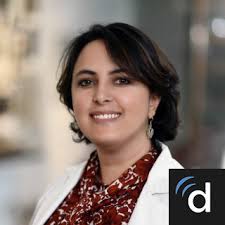
Texas doctor creates cartoons to explain science behind COVID-19. Dr. Valentina Hoyos Velez didn't realize she was an artist until the COVID-19 pandemic hit. Hoyos Velez, a breast oncologist and assistant professor at the Baylor College of Medicine, typically treats cancer patients and is a researcher who focuses on immunotherapies in her laboratory. "I always thought we need to get better treatments, treatments that don't have so much toxicities, that are better tolerated, and that actually can cure cancer," Hoyos Velez said. "The more I learned about it, the more I, in my opinion, thought that immunotherapy is the way of the future for that." Trying to simplify explanations about immunotherapies to patients, paired with spending more time at home during the COVID-19 pandemic, Hoyos Velez tried to get creative- with cartoons. "I realized that many people were refusing to get the vaccine because they didn't really understand how it worked, and there was a lot of misconceptions about it that I found online, and my patients would ask me things that really just made no sense," Hoyos Velez said. "So I said, 'Well, maybe I'll just put a pause on the explaining... (read more)

"Scheduling Angels" are scouring the internet to book vaccine appointments for strangers. Volunteers across Texas have stepped up to help seniors, non-English speakers, and others in need navigate an opaque system. Shanti Shahani de Venegas was one of millions of Texans who struggled to stay warm through last week's winter storm. On the night of February 15, the Plano resident kept logs burning in the fireplace as her family slept. Between poking at the embers, she stayed busy in her fight against the other ongoing crisis: the pandemic that has killed more than 40,000 Texans. Using the wireless hotspot from her phone and an external battery to keep it charged, she scoured the web for vaccine appointments. By the time her battery died at 4 a.m., she'd been able to sign up more than thirty people to get their shots. Shahani de Venegas said her decision to work through the night was twofold: The first reason was that she simply needed... (read more)
Updated: February 17, 2021

California mayor says U.S. must help Mexico with COVID-19 vaccinations, otherwise border economy will lag. About a month ago, the city of Tijuana and other cities in the Mexican border state of Baja California began vaccinating healthcare workers. Back then, health officials said their plan was to vaccinate most people by the fall. But less than two weeks later, Mexico announced the number of vaccines promised was not going to be delivered in the immediate future. Since then, vaccinations have lagged. According to a world COVID-19 vaccination tracking service, Mexico has vaccinated just under 720,000 residents. In comparison, the U.S. has inoculated 43.2 million people north of the border. At this pace, Mexico would need more than 60 years to vaccinate 70% of its population. "The vaccine rollout in the U.S. has been slow, it's getting better, but in Mexico it's been an absolute disaster," said Imperial Beach Mayor Serge Dedina. Dedina's city lies just north of the border from Tijuana."If Mexico remains unvaccinated, it could... (read more)

COVID testing protocols not clear as border crossings surge. Holding her young daughter, 18-year-old Ana from El Salvador said she made the month-long journey to McAllen, Texas for her child. KHOU isn't identifying Ana and isn't using her last name to protect her identity in case her life is in danger in her home country. "More than anything, I did it for my daughter," she said in Spanish. "Because over there, she can't have the same things she can have here." The reasons for coming to this country don't change based on who's in the White House. "I want to find a job so I can work for my little girl," Ana said. People like Ana still make the journey and in recent weeks, hundreds of undocumented immigrants who crossed into the United States were apprehended by Border Patrol and then released into the communities in the Rio Grande Valley, according to nonprofit organizations that work with the population and the City of Brownsville statistics. "For the last year and a half, since MPP (Migrant Protection Protocol, a Trump Administration policy of having... (read more)

Some foreign nationals are getting coronavirus vaccines in the United States. One of Mexico's best-known TV hosts sat in a car, masked, looking straight ahead while a needle was plunged into his bare upper arm. Juan Jose "Pepillo" Origel was the latest Mexican national to get a dose of coronavirus vaccine - by coming to the United States. "Vaccinated! Thank you #USA how sad that my country didn't provide me with this security!!!" the 72-year-old star tweeted in Spanish on Jan. 23, along with a photo of his inoculation in the parking lot of the Miami zoo. Mexican social media users immediately criticized Origel, protesting that his ability to fly to the United States to be vaccinated, crystallized their nation's vast inequities. About the same time, Florida health leaders, concerned that out-of-state residents and foreign nationals were flocking in for precious doses of scarce coronavirus vaccine, moved to restrict access to full- or part-time residents of... (read more)
Updated: February 3, 2021

The 'Dr. Fauci' of the Texas border is counting the dead. Laredo, Texas, is enduring the country's worst outbreak at the end of the pandemic's deadliest month. A crusading cardiologist, leading the fight, is begging the state to close down his city. Each day at around 6 p.m., Dr. Ricardo Cigarroa goes through the same grim ritual. He sits at his desk and counts the dead. "Five to seven death certificates, that's how many I'm signing every single day," Dr. Cigarroa, a 62-year-old cardiologist, said as he stared at the paperwork piling up one afternoon last week. "It only gets worse." At the end of the pandemic's deadliest month, Laredo held the bleak distinction of having one of the most severe outbreaks of any city in the United States. As cases soar, the death toll in the overwhelmingly Latino city of 277,000 now stands at more than 630 - including at least 126 in January alone. When the virus made its way to the borderlands almost a year ago, the bespectacled Dr. Cigarroa could have just hunkered down. He could have focused on his profitable cardiology practice, which has... (read more)

COVID-19 testing for travel from Mexico to the U.S. The U.S. government cannot administer or provide COVID-19 testing for persons abroad who wish to travel to the United States. For a list of COVID-19 testing sites in Mexico, click here. Last updated: January 25, 2021. Local service providers in Mexico can administer the COVID-19 test, with results typically available within 72 hours. The Embassy/Consulates cannot administer or pay for tests. The Department of State assumes no responsibility or liability for the professional ability, reputation, or the quality of services provided by the entities or individuals whose names appear on this list. Many clinics / labs on this list offer "home visits" throughout the region at an additional cost. Please contact the clinic / lab directly for details.
|
|
How COVID-19 is ravaging two cities across the US- Mexico border, with no end in sight - Business Insider video. Two cities across the US-Mexico border, El Paso and Ciudad Juárez, are both COVID-19 hotspots that are struggling to fight the pandemic.
|
Updated: January 22, 2021

The place hit hardest by the virus. The coronavirus has disfigured Gallup, a small New Mexico town near Native American reservations that is now one of the hardest hit places in the country. Hospitals in Gallup are nearly full. Most stores are empty. The unemployment rate in the county where the city sits is one and a half times the national average. Earlier this month, it had the most cases per capita of any metro area in the United States, according to a New York Times database. As the pandemic has steadily marched across the country in recent months, places like Gallup have been among the hardest hit. Perched between the Navajo Nation to the north and Zuni Nation to the south, almost half of Gallup's residents are Native American, according to census data. Native American communities have been particularly vulnerable to the virus, at one point accounting for nearly 40 percent of all cases in New Mexico, even though those communities make up less than a tenth of the state's population. And some who have so far been spared by the virus are nonetheless reeling from the consequences of the... (read more)
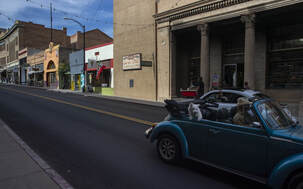
Pandemic closures alter the rhythm of life in towns on both sides of the U.S.-Mexico border. Jesus Tarazon crouched down, gently guiding the yellow Labrador into the back seat of her owner's Subaru. The veterinary assistant waved as the car pulled away, then glanced at his phone. It was 5:06 p.m. - his shift was ending, and he had five hours to make it back home across the border, a relief on days he has to run errands. "Everyone who lives across the line has to watch the clock closely," said Tarazon, a U.S. citizen who commutes daily from his rural home in Mexico to his job here in this southeastern Arizona town, 12 miles from the border. "The pandemic has changed a lot." For Tarazon and the thousands of other local residents who commute between the U.S. and Mexico, pandemic-related border restrictions have altered the rhythms of daily life. The 28-year-old, who adores his work at the animal hospital, often has dinner in Bisbee after his shift - which ends at 5 p.m. most days - and takes his time heading home to his... (read more)
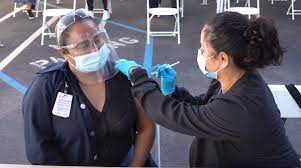
Once a model, California now struggles to tame COVID-19. Ambulances waited hours for openings to offload coronavirus patients. Overflow patients were moved to hospital hallways and gift shops, even a cafeteria. Refrigerated trucks were on standby, ready to store the dead. For months, California did many of the right things to avoid a catastrophic surge from the pandemic. But by the time Gov. Gavin Newsom said on Dec. 15 that 5,000 body bags were being distributed, it was clear that the nation's most populous state had entered a new phase of the COVID-19 crisis. Now infections have been racing out of control for weeks, and California remains at or near the top of the list of states with the most new cases per capita. It has routinely set new marks for infections and deaths, and began the new year reporting a record 585 deaths in a single day. Experts say a variety of factors combined to wipe out the past efforts, which for much of the year held the virus to manageable levels. Cramped... (read more)
Updated: December 16, 2020

For a border funeral home that survived the cartels, the coronavirus crisis is worse. Perches Funeral Homes has been burying bodies for more than half a century, through wars, cartel violence, epidemics and mass shootings, but nothing has filled its crematoriums, chapels and cemeteries like the coronavirus. "The soonest I could do it is in two weeks," funeral director Richard Villa told Brissa Leony, who had come to make arrangements for her grandfather last week. Villa looked at her. He knew. He had almost lost his 87-year-old mother to the virus this year. "Was it COVID?" he asked. Leony nodded. Villa made a note in the family's paperwork. The latest surge in deaths has overwhelmed even a funeral director who has spent four decades laying people to rest. Perches has had to cancel overnight velorios, or wakes, and delay burials and cremations. El Paso County this week had more COVID-19 cases per capita - 91,150 - than any other large metro area in Texas, with 1,282 deaths. Even more have died of COVID-19 across the border in Ciudad Juarez: 2,262. Heavyset and in a dark suit, Villa, 59, has the air of a man long past exhaustion. He sees... (read more)

'Small town, no hospital': Covid-19 is overwhelming rural west Texas. As cases soar in Texas, hospitals are filling up from El Paso to Lubbock. The Big Bend region is especially vulnerable, with just one hospital for 12,000 square miles. It is one of the fastest-growing coronavirus hot spots in the nation, but there are no long lines of cars piled up for drive-through testing and no rush of appointments to get swabbed at CVS. That's because in the rugged, rural expanse of far West Texas, there is no county health department to conduct daily testing, and no CVS store for more than 100 miles. A handful of clinics offer testing to those who are able to make an appointment. Out past the seesawing oil pumpjacks of Midland and Odessa, where roadrunners flit across two-lane roads and desert shrubs freckle the long, beige horizon, the Big Bend region of Texas is one of the most remote parts of the mainland United States and one of the least equipped to handle an infectious disease outbreak. There is just one hospital for 12,000 square miles and no heart or lung... (read more)

Travel restrictions at the US-Mexico border extended through the holidays. Just weeks ago, officials in the United States and Mexico extended travel restrictions at the border until Dec. 21. Now, they've been extended again - this time until late January. Restrictions at the U.S.-Mexico border first implemented in March to help slow the spread of the coronavirus are now set to remain in place until at least Jan. 21. They're meant to prevent travel the U.S. State Department has defined as nonessential, like tourism, shopping and recreational activities. Travel for medical purposes, work or school is considered essential. U.S. citizens and permanent residents are not prevented from returning home under the restrictions. And because there is minimal southbound enforcement, many people in the U.S. have continued crossing the border with little difficulty, while most of their neighbors in Mexico have been unable to cross for nearly... (read more)
Updated: December 3, 2020

US borders with Canada, Mexico will stay closed through December: 'These measures are with us for a while.' If you were hoping that the United States' borders would reopen for holiday travel, don't get your hopes up. The land borders with Canada and Mexico will remain closed through Dec. 21, Chad Wolf, acting secretary of the U.S. Department of Homeland Security announced on Thursday. "In order to continue to prevent the spread of COVID, the US, Mexico, & Canada will extend the restrictions on non-essential travel through Dec 21," he wrote on Twitter. "We are working closely with Mexico & Canada to keep essential trade & travel open while also protecting our citizens from the virus. Canada's Minister of Public Safety and Emergency Preparedness Bill Blair, wrote on Twitter that border-closure decisions"will continue to be based on the best public health advice available to keep Canadians safe." Though these travel restrictions have been extended in monthly increments throughout the course of the COVID-19 pandemic, the borders are not expected to open anytime soon. The U.S.... (read more)

Lawyers: Children detained at border facing COVID exposure. Immigration lawyers say Border Patrol agents are detaining about 65 immigrant children at a station in South Texas in poor conditions, with no room for social distancing and some wearing the same masks they had when they crossed the border. Border Patrol agents are detaining about 65 immigrant children at a station in South Texas in conditions that don't control the spread of the coronavirus, with limited social distancing and a lack of access to soap or hand sanitizer, immigration lawyers said Friday. A lawyer who visited the station at Weslaco, Texas, on Wednesday spoke to teenagers who had been detained there for at least three days, said Carlos Holguin, co-founder of the Center for Human Rights and Constitutional Law. One of the teens, a 15-year-old boy, said in an affidavit that he was allowed to shower for five minutes a day and waits to shower in a line with no room for social distancing, Holguin said. The boy said he was given a single face mask that he has to wear every day. A 13-year-old said... (read more)

Border crossings, expulsions surge during pandemic. MICHEL MARTIN, HOST: We're going to head now to the U.S.-Mexico border, which remains largely closed to migrants because of the coronavirus pandemic. But the number of illegal border crossings is way up and so are expulsions. As Alisa Reznick of Arizona Public Media reports, migrants are desperate to escape conditions in desolate Mexican border towns. ALISA REZNICK, BYLINE: Eighteen-year-old Roberto was terrified of crossing the Sonoran Desert in southern Arizona. ROBERTO: (Through interpreter) Yes, I was very afraid. I heard many people die in that desert because of dehydration and because they were bitten by a snake. REZNICK: Roberto fled gang violence in El Salvador to find a new life with an uncle in the U.S. He asked that we not use his last name because he fears for his life. Twice, he crossed the border, illegally, and twice he got caught. U.S. Border Patrol agents immediately sent him back to Sasabe in Mexico under pandemic-era protocols that allow agents to rapidly expel most migrants with no... (read more)
Updated: November 19, 2020

New Mexico Governor shuts down state for 2 weeks to curb COVID-19 spread. The state of New Mexico will be shutdown starting Monday, November 16 for two weeks, Governor Michelle Lujan Grisham announced. The statewide public health restrictions were announced Friday. Grisham and state health officials are issuing a statewide order closing in-person services for all non-essential activities in order to slow the spread of the coronavirus and to stop the strain on hospitals and health care providers. The heightened restrictions statewide are effective through Monday, Nov. 30. New Mexicans are instructed to stay at home except for only those trips that are essential to health, safety and welfare - such as for food and water, emergency medical care, to obtain a flu shot or to obtain a test for COVID-19. Essential businesses - such as grocery stores, pharmacies, shelters, child care facilities, gas stations, infrastructure operations and others - must minimize operations and in-person staffing to the greatest extent possible but may remain open for limited essential in-person activities. A complete list of categories of businesses defined as essential is included in... (read more)

El Paso has seen an increase in ambulance calls to international bridges. Why? The intensifying COVID-19 pandemic in the Borderland has prompted more ambulance calls to El Paso's international bridges. What's going on? El Paso and Juárez are suffering a twin surge in coronavirus cases that have overwhelmed hospitals on both sides of the border and stretched resources thin. But crossings at U.S. land ports of entry are currently restricted to U.S. citizens and legal permanent residents. In March, the Department of Homeland Security limited non-essential travel at land ports of entry to slow the spread of COVID-19. In practice, Mexican nationals - including those who hold a tourist visa - are prohibited from crossing. Crossing for "a medical purpose" is considered an "essential" reason, but Mexican nationals must show documentation of an appointment for a... (read more)

The coronavirus is now another risk of U.S. migration. At least 2,500 Mexicans in the United States, many of them essential workers, have died from COVID-19. Back home in Mexico, their grieving families are left without support. When Claudio Ortega Maldonado was 17, he left his home in the mountains of Guerrero, never to return. Ortega knew what awaited him if he stayed: He grew up in poverty in a family of seasonal farmers and began working as a child. He hoped to offer his parents and 11 siblings a better life with the money he sent home from New York City, and to build a house in Mexico that he could eventually return to. After 13 years away, he wanted to surprise his family and come home on Mother's Day this year. Instead, Ortega died of the coronavirus on April 22 in a Brooklyn hospital at the age of 29. In New York, Ortega had quickly landed a job as a cook, though he was undocumented. He worked 10-hour shifts six days a week, earning $3,000 a month-and sending $450 each month to his family. He sent presents for his siblings such as clothes and... (read more)
Updated: November 5, 2020

Mexican border state of Chihuahua returns to lockdown. Mexico's northern border state of Chihuahua has returned to the highest level of alert and lockdown after coronavirus cases jumped there and hospitals began to fill up. Mexico's northern border state of Chihuahua returned to the highest level of alert and lockdown Friday after coronavirus cases jumped there and hospitals began to fill up. The Chihuahua state government declared the return to the "red" level of alert Friday, which closes down most non-essential services and encourages people to stay at home. The Health Department said the state's hospital beds were now 69% occupied, and that only about 23% of intensive care beds were open. The department said steps were being taken to expand hospital facilities. The department also said that three other northern states - Durango, Coahuila and Nuevo Leon - were at risk of returning to maximum alert unless infections were brought under control. Nationwide, 19 of Mexico's 32 states will be at high alert starting Monday, 11 will be at medium alert and one state was considered at moderate risk level. Mexico as a whole has seen.. (read more)

Cities on both sides of U.S.-Mexico border strain under coronavirus surge. NPR's Ari Shapiro speaks with Angela Kocherga, news director at KTEP radio station, about the coronavirus surge along the U.S.-Mexico border. ARI SHAPIRO, HOST: El Paso, Texas, and Juarez, Mexico, are effectively one community that crosses a border, and they're being hit hard by a surge of coronavirus cases. On the U.S. side, El Paso County health officials have reported more than 1,400 newly infected people, a record. More than 800 people are now hospitalized. High school football is on hold, and county leaders are recommending people stay home. They've enacted a nighttime curfew in hopes of keeping people inside. For more on the situation, let's bring in Angela Kocherga, who joins us from El Paso. Hi, Angela. ANGELA KOCHERGA, BYLINE: Hi, Ari. SHAPIRO: So what are officials saying there in El Paso? KOCHERGA: Well, they're bracing for another bad week, as they try to contain rampant community spread. And, of course, a big concern are hospitals that reached capacity this past weekend. And there's a mobilization to increase critical care hospital beds, and there have been some tents set up outside of... (read more)

Immigrants, border families face difficulties amid COVID-19 travel restrictions. Travel restrictions have affected Americans and international travelers alike, but perhaps no one feels border-crossing conundrums more acutely than immigrants and their loved ones. And with the COVID-19 pandemic surging in several countries, their situations are likely to worsen before they improve. The U.S. borders to both Mexico and Canada are closed through at least Nov. 21, according to a tweet from Acting Department of Homeland Security Secretary Chad Wolf earlier this month. "To continue to limit the spread of COVID, the US, Mexico, & Canada will extend the restrictions on non-essential travel through Nov 21," the tweet reads. "We are working closely with Mexico & Canada to identify safe criteria to ease the restrictions in the future & support our border communities."Canadian Prime Minister Justin Trudeau said his country will keep the border closed until the U.S. gets control of the coronavirus, which causes COVID-19 - and USA TODAY's analysis of the... (read more)
Updated: October 21, 2020
COVID-19 relief funds across Borderlands grow to over US$120,700,000. Generosity knows no borders and that is certainly true in the U.S.-Mexico Border region. Community, public, and private foundations from San Diego to San Antonio on the U.S. side of the Border, and from Tijuana to Matamoros on the Mexico side of the Border have responded to the health pandemic with incredible speed and generosity. As of today, more than US$120 million has been secured to help families and communities in need. This is due to the incredible generosity of thousands of donors that believe in their community and want to help those in need. Funds have been disbursed to: help nonprofits deliver food to the hungry; provide economic relief to the unemployed; medical equipment to first responders; daycare for essential workers; grants to small businesses in jeopardy of closure; and many other needs identified by organizations along and across the region. Click here to see how foundations, corporations, community development programs, and local governments are collaborating in your community. You may also wish to consider a donation to the foundation nearest you.
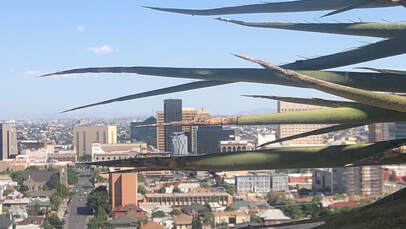
What does the state of COVID-19 look like in other US-Mexico border cities? As El Paso battles through another wave of COVID-19 cases, KFOX14 went digging into how other cities with a similar dynamic are handling the virus. "We are not different than any other community," the Medical Authority for Hidalgo County, Dr. Ivan Melendez, said. In the world we live in now, there is one unsettling factor every state, county and city have in common: the coronavirus. "People just don't get it," Melendez said. On Sunday, 684 new COVID-19 cases were reported in El Paso, bringing the total number of active cases to over 8,000. "We still have the highest mortality rate in Texas," Melendez said. Hidalgo County is leading the fight against COVID-19 in the Rio Grande Valley. "Our numbers dropped to about 20 percent of what they were at the highest point," Melendez said. Just a few months back, Hidalgo County faced a second wave of COVID-19, seeing a surge in cases similar to what El Paso is seeing now. "Not helpful at all," Melendez said. Melendez said that... (read more)

Experts project increase in migrants at US-Mexico border as pandemic devastates Latin America. Immigration experts are expecting an increase in the number of migrants journeying to the US-Mexico border in the coming months following the devastating impact of the coronavirus pandemic on Latin America. As countries put lock downs in place earlier this year, the number of Central Americans migrating north dropped. From March to April, arrests on the US-Mexico border plummeted from 30,389 to just over 16,000, before gradually ticking up again, according to US Customs and Border Protection data. Ebbs and flows in migration are common, but after a pandemic that's taken the lives of thousands in Latin America, border experts expect that upward trend to continue as restrictions in Central America are eased. "We interviewed dozens of government and NGO leaders in Central America and Mexico, and there was a broad... (read more)
Experts project increase in migrants at US-Mexico border as pandemic devastates Latin America. Immigration experts are expecting an increase in the number of migrants journeying to the US-Mexico border in the coming months following the devastating impact of the coronavirus pandemic on Latin America. As countries put lock downs in place earlier this year, the number of Central Americans migrating north dropped. From March to April, arrests on the US-Mexico border plummeted from 30,389 to just over 16,000, before gradually ticking up again, according to US Customs and Border Protection data. Ebbs and flows in migration are common, but after a pandemic that's taken the lives of thousands in Latin America, border experts expect that upward trend to continue as restrictions in Central America are eased. "We interviewed dozens of government and NGO leaders in Central America and Mexico, and there was a broad... (read more)

Worked to death: Latino farmworkers have long been denied basic rights. COVID-19 showed how deadly racism could be. Latinos were denied fair pay, leaving them vulnerable to COVID-19. In this six-part series, USA TODAY investigates how racism killed people of color. José Alfredo Reyes' wife and son pulled on personal protective gear and entered his San Diego hospital room. "Can you hear us?" Margarita Reyes said. Her husband's eyes remained shut, but his body twitched. She leaned in low to his ear and told him that his elderly mother, his children and his grandchildren would all be OK. She told him she loved him. Ten minutes later, José Alfredo Reyes, 59, was dead. José Alfredo Reyes, a longtime farmworker in this agricultural county of 181,000, is one of thousands in Imperial County to be sickened or killed by COVID-19, the disease spawned by the coronavirus. Imperial County, which is 85% Hispanic, has consistently had one of the highest death rates in the United States, at a time when... (read more)
Updated: October 8, 2020

U.S.-Mexico border strains under the weight of a partial closure. Street vendor Patricia Ramirez stares at the thinning line of cars along Juarez Avenue and moans with dread. Street vendor Patricia Ramirez stares at the thinning line of cars along Juarez Avenue and moans with dread. Ramirez is four months pregnant with her second child. She sells trinkets - everything from candy and gum to Mexican flags - mostly to people crossing the border. But there are few customers now and sales have declined by more than 70%, she said. She simply doesn't know how she'll make ends meet. It's been a little more than six months since the U.S. and Mexico restricted the border to "non-essential" traffic to curb the spread of the deadly coronavirus. Most people who live, work and study on both sides of the Rio Grande are not crossing the border. Overall, traffic is way down. But many continue to cross despite not being on "essential" errands. And COVID-19 is still out of control in both nations. Rivera says she understands why the restrictions... (read more)
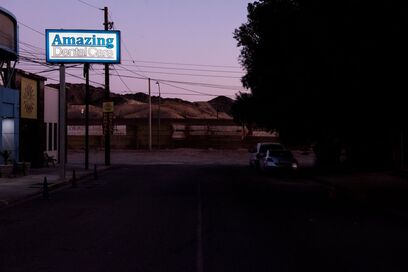
Medical tourism was booming in Mexican border towns. then came the coronavirus. Americans and Canadians are reluctant to visit "Molar City" and other Mexican destinations due to confusion about COVID-19 travel restrictions. From Tijuana to Nuevo Progreso, Mexican towns near the U.S. made a big bet that the high cost of health care in the United States would bring patients and money south of the border for surgeries, dental care and prescription medicines. Yet amid the novel coronavirus pandemic, that bet has looked like less of a sure thing as travel ground to a halt, businesses shuttered and jobs disappeared. In Los Algodones, a small town bordered by California to the north and Arizona to the east, dentistry dominates the local economy. The town has just 5,000 residents, but it's home to hundreds of dental clinics, drugstores and other medical facilities meant not for locals but for foreigners. During the busy winter season, thousands of Americans and Canadians flock to Los Algodones for dental work that's 40% to 50% less expensive than in their home countries. That's why the town has earned the... (read more)

Six month after US-Mexico border closed, residents on both sides struggle to adapt. It's been more than six months since the U.S. and Mexico border closed to all but essential travel to slow the spread of COVID-19. The disruption of lives and livelihoods has been widespread on both sides during the pandemic. Marco Antonio Corral, 60, has watched it all unfold from the middle of the Paso del Norte Bridge where just over the borderline on the Mexican side he peddles potato chips and cold water to drivers and passengers stuck in idling cars calling out "Papitas! Agua!" The father of five says his sales have been cut in half since the shutdown started in March. "It's not right that Mexicans can't cross. They should close it to everyone to be fair," said Corral. Some U.S. citizens and legal permanent residents continue to go back and forth across the border. Mexican authorities do not stop visitors and U.S. Customs and Border Protection cannot prevent Americans from returning home from Mexico. On a recent afternoon, a line of cars and trucks waits to enter from Juarez and in El Paso people gather near the pedestrian entrance headed to Mexico. Marisol Marin crosses back and about three times a week to work in El Paso. She's a U.S. citizen but... (read more)
Updated: September 23, 2020

In border states, U.S., Mexico point fingers at each other over coronavirus spread. Uninsured Texans cross the Rio Grande into the Mexican border town of Matamoros in search of cheap prescriptions and affordable medical care. Some of them go to see Dr. Antonio Alfaro, an internal medicine specialist who treats a steady stream of patients with diabetes, hypertension and obesity - COVID-19 comorbidities common on both sides of the border. Entering Mexico for a medical appointment is considered essential travel under the pandemic border restrictions in place since March. But in recent weeks, U.S. border officials have started to carry out more checks on Americans returning from Mexico at land crossings - in a bid to limit non-essential travel and slow the spread of COVID-19. It's a move that rankles Dr. Alfaro, who oversees the COVID-19 response in Matamoros's main public hospital, especially as he sees more pandemic precautions being taken on the Mexican side, in the city opposite Brownsville, Tex. "You can't blame your neighbour for what's happening in your own home," Dr. Alfaro said. "When the... (read more)

Majority of kids who die of coronavirus are Hispanic, Black, or Native American, CDC finds. As students across the country return to classrooms, a new report from the Centers for Disease Control and Prevention found the majority of children, teens and young adults who die from COVID-19 are Hispanic, Black or Native American. Researchers found there was a staggering racial disparity in the more than 390,000 coronavirus cases and 121 deaths among people under the age of 21 reported to the CDC between Feb. 12 and July 31. Hispanic, Black and Native American children accounted for 78% of those deaths even though those groups represent just 41% of the United States population, a disproportionate effect that reflects a similar disparity among adults. Previous research has shown that the death toll from COVID-19 is twice as high for people of color under the age of 65 as it is for white Americans. "The findings did not... (read more)

Medical care for migrants at border at risk of lapsing, government watchdog warns. The government watchdog office for the United States' border security agency warned Tuesday of a possible lapse in medical care services for migrants at the U.S.-Mexico border, which could pose a risk to the health of border agents and officers amid the COVID-19 pandemic. The Office of the Inspector General for the U.S. Department of Homeland Security published a management alert, its most-urgent level of warning. U.S. Customs and Border Protection is running out of time to award a new contract to keep medical services uninterrupted, it said. The current contract, awarded in 2018 to Loyal Source Government Services of Orlando, Florida, for $136 million, is set to expire Sept. 29. That leaves CBP with less than three weeks to solicit proposals and award a new contract. "A lapse in onsite medical services at CBP facilities could jeopardize the health and safety of migrants in CBP custody, who may already be at higher risk of more severe illness from COVID-19," the OIG management alert said. On any given day, Loyal Source Government Services has about 440 medical professionals available at 67... (read more)
Updated: September 10, 2020
COVID-19 relief funds across Borderlands grow to over US$120,700,000. Generosity knows no borders and that is certainly true in the U.S.-Mexico Border region. Community, public, and private foundations from San Diego to San Antonio on the U.S. side of the Border, and from Tijuana to Matamoros on the Mexico side of the Border have responded to the health pandemic with incredible speed and generosity. As of today, more than US$120 million has been secured to help families and communities in need. This is due to the incredible generosity of thousands of donors that believe in their community and want to help those in need. Funds have been disbursed to: help nonprofits deliver food to the hungry; provide economic relief to the unemployed; medical equipment to first responders; daycare for essential workers; grants to small businesses in jeopardy of closure; and many other needs identified by organizations along and across the region. Click here to see how foundations, corporations, community development programs, and local governments are collaborating in your community. You may also wish to consider a donation to the foundation nearest you.

Essential workers face delays at U.S.-Mexico border due to new CBP regulations. U.S. Customs and Border Protection officials have instituted new policies to discourage nonessential travel across the Mexico border. It has resulted in major delays for essential workers as well. The U.S. border with Mexico has been closed to nonessential travel since March 21 due to the coronavirus. But despite those restrictions, cross-border traffic has increased since then. So U.S. Customs and Border Patrol has started using new tactics to discourage nonessential travel, and that's making it harder for those who need to cross for essential work. KPBS reporter Tania Thorne explains. TANIA THORNE, BYLINE: Andres Roberto Moreno is a Mexican food service worker who crosses daily for his job in California. He says that for the last month, he's had to... (read more)
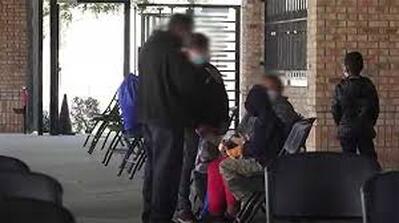
Coyotes are now smuggling migrants back home after they've given up on America. Travel restrictions around COVID-19 across Latin America mean some of those who want to get back home have to do it illegally. Hazel Lazo was lucky. She made it to the United States from El Salvador with legal permission. That meant she didn't have to risk the epic journey via land from Central America that some don't survive. But within months, because of the pandemic, she ran out of money and options in the U.S and decided to go home. And she needed a people smuggler to do it. "I thought about all the people who want to be there, in the U.S, and they risk their lives to get there. We risked ours again, but in reverse this time, to get back to El Salvador," she said. Regional border closures in response to the threat of the coronavirus have generated a new migration phenomenon: migrants from Central American nations such as Honduras and El Salvador having to... (read more)

Border workers do not risk being late and prefer to sleep at the Otay Mesa gatehouse. At the pedestrian crossing people sleep in line waiting for the border to open. People have been sleeping in their cars at the Otay border to wait for the port of entry to open; it started happening after the hours of service of the border port of entry were reduced. Dozens of workers sleep on the sidewalk or in their cars to be the first to cross the border once the Otay Mesa gate opens. This image has been a constant since the port of entry, which previously operated 24 hours, closed at night. They can't afford to be late, so they prefer to sleep uncomfortably before risking the unpredictable lines at San Ysidro. Since the beginning of the month, the Otay Mesa gatehouse operates from 6 a.m. at 10 p.m., in response to a decrease in the volume of border crossings stemming from travel restrictions imposed by the COVID-19 pandemic. In response, border traffic in the Tijuana-San Diego region is concentrated at the San Ysidro gate that... (read more)
Updated: August 27, 2020
Borderlands Foundations secure over US$89,920,000 in COVID-19 relief for families and communities. Foundations across the U.S.-Mexico Borderlands have established COVID-19 response funds to help families and communities in need. From San Diego to San Antonio philanthropic organizations have nearly US$90 million to support relief programs where they are most needed. Click here to see how foundations, corporations, community development programs, and local governments are collaborating in your community. You may also wish to consider a donation to the foundation nearest you.

Health and financial risks for noncitizen immigrants due to the COVID-19 pandemic. The COVID-19 pandemic has taken a disproportionate toll on some groups of individuals, including lower income individuals and people of color. One group who faces risks and challenges associated with the pandemic is the nearly 22 million noncitizen immigrants living in the U.S. today. Non-citizen immigrants were already facing a range of challenges prior to the pandemic, including increased fear and uncertainty due to shifting immigration policy that was leading some to turn away from accessing programs and services. As virus hotspots have risen in the Southern and Western regions of the country, with reports of increases in towns along the U.S.-Mexico border, understanding the risks and challenges facing noncitizen immigrants is of increasing importance. This brief analyzes key characteristics of noncitizen immigrants to examine the health and economic risks they face amid the pandemic. It finds: Noncitizen immigrants are more likely to live in large households and in... (read more)

Longer wait times expected at US border under new COVID-19 protocols. There will be additional lane closures and customs inspections. The U.S. will slow down the flow of traffic at select ports of entry on the Southwest border to further limit the spread of novel coronavirus by travelers coming from Mexico, a Customs and Border Protection official confirmed on Saturday. Non-essential travel has been limited since March, but the new measures may increase wait times at ports of entry in San Diego, California; Tucson, Arizona; and El Paso and Laredo, Texas. Reuters first reported on the additional lane closures and customs inspections that will likely delay anyone traveling for non-essential reasons. "We're committed to continuing to facilitate cross border movement of essential travelers," CBP spokesperson Nate Peeters said. "These measures are only intended to address non-essential travel with the ultimate goal of the further inhibiting the cross-border spread of COVID-19." The restrictions on... (read more)

The world needs to reopen borders before it's too late. Even as they struggle to control the pandemic, governments should move quickly to reopen borders instead of giving in to xenophobia, nationalism, and illusions of autarky. Right now, it is hard to imagine a greater threat to the world's well-being than the COVID-19 pandemic. More than 23 million people have tested positive for the virus-likely just a fraction of the actual spread-and more than 800,000 have died. The pandemic has battered the global economy, with the World Bank predicting global GDP to drop by more than 5 percent this year, a true worldwide depression far worse than the downturn in 2008 and 2009. But COVID-19 is not the biggest threat the world faces. An even greater danger today is rising nationalism, which threatens to undermine international cooperation on vital issues including not only global public health but climate change and trade. And government responses to the pandemic, which have focused on border closings, travel bans, and reshoring the production of medical and other goods, are fueling the narrative that foreign people and foreign goods are a source of danger and... (read more)
Updated: August 13, 2020
Borderlands Foundations secure over US$60,300,000 in COVID-19 relief for families and communities. Foundations across the U.S.-Mexico Borderlands have established COVID-19 response funds to help families and communities in need. From San Diego to San Antonio philanthropic organizations have raised over US$60 million to support relief programs where they are most needed. Click here to see how foundations, corporations, community development programs, and local governments are collaborating in your community. You may also wish to consider a donation to the foundation nearest you.

San Diego to offer coronavirus tests at US-Mexico border. Essential workers coming into the United States from Mexico and returning U.S. citizens will be offered the tests at the appointment-free, walk-up site. San Diego County plans to set up its first testing site for the coronavirus at one of the world's busiest pedestrian international border crossings, officials said Wednesday. County Supervisor Greg Cox said that the county will begin tests in about two weeks at the San Ysidro port of entry's PedWest crossing, which is exclusively pedestrian and connects Tijuana, Mexico to San Diego. An estimated 20,000 pedestrians enter the United States at the crossing daily, though that number has dropped with the pandemic and the shuttering of businesses. Essential workers coming into the United States from Mexico and returning U.S. citizens will be offered the tests at the appointment-free, walk-up site, Cox said. County officials expect to do... (read more)
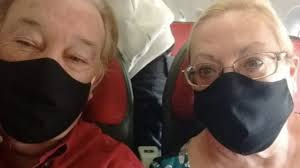
Retirees living in Mexico worry about possible border plans aimed at COVID-19. Concerns continue to grow amid reports that President Trump may allow border officials to ban US citizens suspected of having coronavirus from re-entering the country. Five years ago, Les and Marilyn Widd retired and made a big move, buying an oceanfront home in Rosarito, Mexico. That dream retirement has suddenly been marred by worries about COVID-19 and a possible presidential action. According to published reports, President Trump is weighing rules to allow border officials to temporarily block an American citizen or legal permanent resident from entering, if there is reason to believe the person has coronavirus. "Absolutely upsetting, absolutely upsetting," said Les Widd, 70. Details about the possible plan are unknown, but Widd has heard enough. "It's violating your constitutional rights to receive treatment in your own country," said Widd. Widd says if either of them were to... (read more)

Ending 'asylum as we know it': Using pandemic to expel migrants, children at border. When a Salvadoran woman grabbed her 4-year-old daughter and fled their home country in February, the coronavirus wasn't yet a global pandemic. By the time they reached the U.S.-Mexico border a month later, that had changed. She crossed the Rio Grande, planning to ask for asylum. But Border Patrol agents took her and her daughter right back to Mexico, despite her pleas. "They told me they didn't care," the woman said in Spanish, asking us not to use her name, out of fear for her safety. "They didn't care what happened to my life. That I had to go - whether to Mexico, to El Salvador, to wherever I wanted, but I wasn't getting into the U.S." Since March, immigration officials have turned away tens of thousands of migrants like this woman and her daughter. They carried out more than 105,000 rapid expulsions through the end of July, under a public health order that... (read more)
Published: July 23, 2020

Vulnerable border community battles virus on 'a straight up trajectory.' In the Rio Grande Valley, poverty and chronic illness are aggravating the coronavirus outbreak. Ambulances stack up outside emergency rooms, where patients wait for beds. On a sweltering day last week near the southern tip of Texas, where high rates of poverty and chronic illness have heightened the ferocity of the coronavirus, Dr. Renzo Arauco Brown made his rounds, checking on patients who were facing severe complications from the virus and barely hanging on to life. The now-chaotic special infectious disease unit where he works has been clobbered with new admissions in recent weeks. Clinicians sweat under layers of protective gear and yell over constantly blaring alarms. Standing over a 63-year-old man whose lungs were taking in dangerous amounts of oxygen from a ventilator, Dr. Brown ordered medication to paralyze the man in hopes it would fix the problem. But it was one of many. The man had also suffered a severe stroke and blood clots because of the virus.

Asylum hearings at U.S.-Mexico border won't restart until COVID-19 criteria met; longer wait time likely. The U.S. Department of Homeland Security and the Justice Department issued on Friday evening new guidance to resume court hearings for migrants who seek asylum in the United States but who are sent to Mexico to wait. The criteria, amid the backdrop of the global COVID-19 pandemic, is likely to result in longer wait times in Mexico for migrants as both countries continue to see the uncontrolled spread of the new coronavirus. Hearings were originally scheduled to resume on Monday for asylum seekers sent to Mexico under a policy called the Migrant Protection Protocols, but more informally known as "Remain in Mexico." Since rolling out the program in January 2019, the U.S. government has sent back more than 60,000 migrants. The new criteria does away with set dates, and instead relies on a series of conditions that must be met before court hearings resume. Those conditions are almost entirely dependent on states on both sides of the U.S.-Mexico border gaining control of... (read more)

'This is a war': the coronavirus disaster in California's hardest-hit - and poorest - county. About 17 patients are airlifted out of Imperial county every day, as the virus takes a devastating toll on Latino residents. In southern California's Imperial county, the chuff-chuff of spinning helicopter blades has become a familiar noise. It's the sound of coronavirus patients being airlifted out - 15 to 17 a day, on average. This remote region along the US-Mexico border is under siege from Covid-19, and hospitals are stretched to the brink. Imperial county, population 181,000, is experiencing California's worst outbreak, according to several public health metrics. Over the last 14 days, the county's infection rate was more than 588 per 100,000 people - by far the highest in the state. As of Friday, the county had recorded 7,759 coronavirus cases and 132 fatalities. Adolphe Edward, the CEO for El Centro regional medical center, one of only two hospitals in the county, is reminded of medical operations he has overseen in Turkey, Oman and United Arab Emirates. More than 500 patients have already been... (read more)

How US immigration officials are spreading the coronavirus. At least one transfer led to a super-spreading event, when the ICE moved 74 detainees, more than half of which later tested positive for Covid-19; three weeks later, that had jumped to 315. Public health specialists have for months warned the US government that shuffling detainees among immigration detention centres will expose people to Covid-19 and help spread the disease. US Immigration and Customs Enforcement (ICE) has continued the practice, saying it is taking all necessary precautions. It turns out the health specialists were right, according to a review of court records and ICE data. The analysis of immigration court data identified 268 transfers of detainees between detention centres in April, May and June, after hundreds in ICE custody had already tested positive for Covid-19, the disease caused by the coronavirus. Half of the transfers identified involved detainees who were either moved from centres with Covid-19 cases to centres with no known cases, or from... (read more)
Updated:: July 9, 2020
Borderland Foundations secure over US$58 million to support families and communities impacted by COVID 19. Since our last newsletter, community foundations from San Diego to San Antonio have secured an additional US$11 million dollars to support COVID 19 relief programs. The generous spirit of Individual donors, small businesses, large corporations, donor advised funds, as well as local, regional, and state governments has responded forcefully to this pandemic. As of today, US$58 million dollars has been donated to support families, communities, nonprofit organizations, small businesses, and more. Click on the links below to see how these BPP member agencies are responding locally to help those most in need. Want to make a contribution? Select the organization nearest you and support their efforts. Need help for your nonprofit organization? Contact the foundation in your area to see how you may qualify for a grant or nonprofit loan.
In California, The San Diego Foundation, San Diego Gas & Electric, Alliance Healthcare Foundation, and United Way of San Diego County joined forces to support families in need and the local nonprofit sector with donations from local partners and donors to create the San Diego COVID-19 Community Response Fund. The International Community Foundation has established a new fund to support outreach activities in Mexico. San Diego Grantmakers is working with the City of San Diego to design and implement the City's Small Business Relief and Support Grant Program with a unique equity lens. The US-Mexico Border Philanthropy Partnership is able to assist you with fiscal agency support and can receive and distribute charitable donations on your behalf, as well as support in-kind gifts to the other side of the border.
In Arizona, the Arizona Community Foundation and their affiliate network established an emergency fund to support nonprofits responding to the Coronavirus and are raising and disbursing funds across the State. They also launched a new fund to support Latino-owned businesses. The Community Foundation for Southern Arizona crafted a community resource guide that is updated daily and has opened a new fund to provide grants and loans to support nonprofit organizations serving the local community.
In New Mexico, the Santa Fe Community Foundation launched the COVID-19 Response Fund to address critical gaps in food security and income during this unprecedented time. The Con Alma Health Foundation continues to be engaged and is providing key information resources as well as health related grants to agencies across the State. The Community Foundation for Southern New Mexico has opened an emergency fund to support nonprofits.
In Texas, the El Paso Community Foundation created the Coronavirus Fund to help people, and nonprofits in the local community deal with the financial pressures brought on by the pandemic. El Paso Community Foundation, FECHAC, and Desarrollo Económico also recently partnered on the UNIDOS Fund to secure additional PPE for hospital workers in Cd. Juarez. The Paso del Norte Health Foundation created the El Paso COVID-19 information hub, and the Paso del Norte Community Foundation is partnering with United Way of El Paso to support the El Paso COVID -19 Response Fund to support nonprofit organizations serving the most vulnerable in the community including the homeless and elderly. The San Antonio Area Foundation, United Way of San Antonio and Bexar Counties, and multiple partners have unveiled the COVID-19 Response Fund to support local nonprofits serving the economically vulnerable.
Please consider supporting one of these local funds established to respond to the COVID-19 pandemic. Your gift joins thousands of others working to build a safe and resilient community in the Borderlands.
In California, The San Diego Foundation, San Diego Gas & Electric, Alliance Healthcare Foundation, and United Way of San Diego County joined forces to support families in need and the local nonprofit sector with donations from local partners and donors to create the San Diego COVID-19 Community Response Fund. The International Community Foundation has established a new fund to support outreach activities in Mexico. San Diego Grantmakers is working with the City of San Diego to design and implement the City's Small Business Relief and Support Grant Program with a unique equity lens. The US-Mexico Border Philanthropy Partnership is able to assist you with fiscal agency support and can receive and distribute charitable donations on your behalf, as well as support in-kind gifts to the other side of the border.
In Arizona, the Arizona Community Foundation and their affiliate network established an emergency fund to support nonprofits responding to the Coronavirus and are raising and disbursing funds across the State. They also launched a new fund to support Latino-owned businesses. The Community Foundation for Southern Arizona crafted a community resource guide that is updated daily and has opened a new fund to provide grants and loans to support nonprofit organizations serving the local community.
In New Mexico, the Santa Fe Community Foundation launched the COVID-19 Response Fund to address critical gaps in food security and income during this unprecedented time. The Con Alma Health Foundation continues to be engaged and is providing key information resources as well as health related grants to agencies across the State. The Community Foundation for Southern New Mexico has opened an emergency fund to support nonprofits.
In Texas, the El Paso Community Foundation created the Coronavirus Fund to help people, and nonprofits in the local community deal with the financial pressures brought on by the pandemic. El Paso Community Foundation, FECHAC, and Desarrollo Económico also recently partnered on the UNIDOS Fund to secure additional PPE for hospital workers in Cd. Juarez. The Paso del Norte Health Foundation created the El Paso COVID-19 information hub, and the Paso del Norte Community Foundation is partnering with United Way of El Paso to support the El Paso COVID -19 Response Fund to support nonprofit organizations serving the most vulnerable in the community including the homeless and elderly. The San Antonio Area Foundation, United Way of San Antonio and Bexar Counties, and multiple partners have unveiled the COVID-19 Response Fund to support local nonprofits serving the economically vulnerable.
Please consider supporting one of these local funds established to respond to the COVID-19 pandemic. Your gift joins thousands of others working to build a safe and resilient community in the Borderlands.
Published: July 9, 2020

Special Report: As cases surge, California struggles to slow COVID-19 in Latino communities. Gov. Gavin Newsom calls them the unsung heroes of the California economy in dangerous times. They are the workers, many of them Latino, who can't afford to shelter in place. They harvest crops, work shoulder to shoulder in factories, prep food in restaurant kitchens and put roofs on houses. Yet until recently, few local public health officers and experts in California focused on another fact about that group: Latinos of working age are getting sick and dying from the coronavirus in disproportionately high numbers. Now, the alarm bell has sounded. After virus testing sites branched out to more diverse communities in recent weeks, the grim severity of the situation is clear. "We have failed our under-served communities," said David Lubarsky, chief executive officer for UC Davis Health, speaking of the overall response to date to the pandemic. UC Davis partnered with Sacramento County and community groups such as La Familia on recent testing in more neighborhoods of color that... (read more)

Between borders. From a doctor stranded in Ciudad Juárez to a shelter closed after an outbreak, COVID-19 is hitting hard along the Texas-Mexico border. Leer en español. This is Part 1 of COVID-19 in the Immigration Pipeline-a series supported by the Pulitzer Center on Crisis Reporting, published by the Texas Observer in collaboration with the Border Center for Journalists and Bloggers. When news of the pandemic arrived, D.T. found herself locked in a cell on the U.S. side of the Paso del Norte bridge more than 1,700 miles from home, pregnant and desperate. The 26-year-old had fled Havana, Cuba in July 2019 to seek asylum after being labeled a dissident and beaten by police. Inside the cell, she began suffering abdominal pains. Perhaps they came from injuries suffered in the most violent of two attacks she'd endured during long months waiting in Ciudad Juárez for her asylum claim to be considered by a U.S. immigration judge. Two other pregnant women shared her cell in March-one looked like she could give birth any minute. D.T., a physician as well as an asylum-seeker, examined their bulging bellies and worried: "Can you imagine... (read more)

People with coronavirus are crossing the US-Mexico border for medical care. Chris Van Gorder says he's seeing a telling trend in the hospitals he runs. Coronavirus patients are showing up in emergency rooms after calling 911 from the US-Mexico border. "They'll literally come to the border and call an ambulance," says Van Gorder, president and CEO of Scripps Health, a hospital system in southern California. The rise in ambulance traffic from the border, which several officials described to CNN, is a symptom of the pandemic's spread in the region -- and a sign of the many connections between communities in both countries. "There just is not a wall for viruses at the border," says Josiah Heyman, director of the Center for Inter-American and Border Studies at the University of Texas at El Paso. "The wall is an illusion, because the two sides are really woven together." An increase in cross-border coronavirus cases, which... (read more)
Published: June 25, 2020

What's behind a COVID-19 spike in Imperial County. In late March, Imperial County had just nine confirmed cases of COVID-19, and the head of the largest hospital there thought his community had dodged a bullet. But Dr. Adolphe Edward soon realized his assessment was premature. "All of a sudden, we had 65 patients with COVID," Edward recounted during a recent interview, "which was over 70 percent of my hospital admissions." Today, the rural county on the U.S.-Mexico border with 180,000 residents has the highest coronavirus infection rate per capita of any California county. As of June 16, the county's public health department reported that 4,389 people had tested positive, and 52 people had died with the virus. The surge in cases is partly due to the county's location right on the international boundary, health officials say. Edward's hospital, the 150-bed El Centro Regional Medical Center, is just a half-hour drive north of Mexicali, a city with over a million residents in Baja California that has become... (read more)

In Ciudad Juárez, a new 'filter hotel' offers migrants a safe space to quarantine. Despite the coronavirus pandemic, Hotel Flamingo in Ciudad Juarez has been filling up with guests. When they arrive, they have to go through a thorough disinfection process. First, they step inside a tray filled with diluted bleach, to clean off the soles of their shoes. Then it's on to a handwashing station, where they're instructed to scrub with a generous amount of soap and follow up with a big squirt of hand sanitizer. Finally, they receive a fresh face mask, and the hotel coordinator sprays their shoes with an alcohol mixture. These guests aren't tourists on vacation. They're people who tried to cross into the U.S. but, for a variety of reasons, have been sent back to this border city and need a safe place to stay. Migrant shelters, which are trying to control the spread of COVID-19, can't immediately take them in. So Hotel Flamingo has been temporarily converted into a "filter hotel" - a space where they can quarantine for 14 days before transferring to a... (read more)

Coronavirus cases surge in Arizona's border counties. Arizona is seeing more COVID-19 cases statewide, but two small counties along the US-Mexico border are seeing particularly troubling trends. In the last month, Santa Cruz county has reported over 1,500 new cases and Yuma County has reported more than 3,000. That's a stark change from numbers those areas have seen in the past - Santa Cruz County had just 69 cases when Gov. Ducey lifted the stay at home order on May 15. Yuma County had 310. Gary Nabhan, an agricultural ecologist and a research social scientist at the University of Arizona, said these are agricultural hubs for the state and the country. Produce is harvested in farmland near Yuma and it's packed and delivered through the border in Nogales. Nabhan said both areas are staffed with essential workers who don't have the chance to stay home when sick. "Whether they're packing the produce in Nogales or... (read more)
Published: June 11, 2020

Border-crossers turn to bikes as lines stretch for hours. Between work in Nogales, Ariz. and family in Nogales, Sonora, Diego Baldenegro finds himself crossing the local border every three or four days. Until about a month ago, that meant getting into his car and crossing through the vehicle lanes at the local ports of entry. "Up until then, in the car it wasn't that bad," he said. "It was like an hour, an hour and a half. Now it's three to four hours, five (in the vehicle lanes), and so your car overheats." On Monday morning, Baldenegro rolled out of the DeConcini Port of Entry on a different set of wheels: a Mongoose mountain bike. "On the bike, it makes (crossing the border) a little easier," he said. Baldenegro is one of a growing number of local residents turning to two-wheeled transit as lines to cross the border on foot or in personal vehicles stretch for hours. Riders who spoke to the NI said that, in recent days, a separate bike line was forming to go through the downtown Dennis DeConcini Port of Entry, with U.S. Customs and Border Protection officers screening... (read more)

Coronavirus on the border: California hospitals overwhelmed by patients from Mexico. When Manuel Ochoa started feeling sick - his body sore, his breathing restricted - he drove from his mother's home in Mexicali, Mexico, to the U.S. border. The 65-year-old retiree parked his car at the international bridge and tried to drag himself to the country where he has permanent residency, and where his health insurance is valid. Just before he approached the Border Patrol checkpoint, he collapsed in the sun. That's when U.S. immigration officials made a call that has become increasingly common during the coronavirus outbreak: for an ambulance to transport a U.S. citizen or resident from the Mexican border to the nearest American hospital. As Mexico's health-care system has strained under the coronavirus, small community hospitals in Southern California, some of the poorest in the state, have been flooded with Americans who have fallen ill and crossed the border. They are retirees and dual citizens, American... (read more)

Mexican families struggle to send remains of virus victims back home. When Crescencio Flores died of coronavirus in New York, his parents back in Mexico asked for one thing: that their son be sent home for burial. The 56-year-old construction worker had been in the United States for 20 years, regularly sending money to his parents but never going home. Since he died in April, Flores' brother has been working with American and Mexican authorities to have the body transported to the town of Huehuepiaxtla in the state of Puebla. So far, his efforts have been in vain. His brother's embalmed remains are still in a U.S. funeral home. "I am trying to do this because my parents, 85 and 87 years old, live there," Francisco Flores said. "They are rooted in their customs. They want a Christian burial for the remains of their son." The family's situation is common. More than a thousand Mexican immigrants have died of the virus in the U.S., according to the Mexican government, and many... (read more)
Published: May 27, 2020
COVID's controversial "washing tunnels" for those crossing the U.S.-Mexico border.

Authorities in the Mexican city of Nogales, which borders Arizona, put those entering the country through a curious "disinfectant tunnel" to prevent the spread of COVID-19. That way, everyone who arrives in Nogales, Sonora, from the international "Mariposas" checkpoint -including pedestrians- must go through these tunnels where they are sprayed with a disinfectant that keeps the body clean and free of the virus for 24 hours, according to a statement from the municipality of Nogales. Health authorities in the region, who have announced that they will install more of these anti-COVID corridors at local border checkpoints, believe that most of the cases of coronavirus recorded in Nogales have been from people crossing from Arizona. There is sufficient data that argues the neighboring state's more than 13,000 confirmed infections could've helped with Sonora's 700, and 34 dead. However, there are those who... (read more)
Coronavirus cases jump along California-Mexico border.

The southernmost counties in California are witnessing an influx in cases. A Southern California county that shares a border with Mexico is seeing a spike in coronavirus cases. The Associated Press (AP) reports that El Centro, a farming community in Mexicali - a town in Mexico on the U.S.-Mexico border - is seeing a rise in coronavirus-related hospitalizations. Some believe this uptick stems from American citizens who live in Mexico coming to the U.S. for care. El Centro Regional Medical Center, located in the Imperial Valley and El Centro metro region, reportedly admitted 14 infected patients on Monday evening, pushing its coronavirus caseload to 65. The hospital temporarily stopped accepting COVID-19 patients due to the surge. As of May 21, the hospital is down to 52 coronavirus patients, per its Facebook page. Nearby Pioneer Memorial Hospital saw a similar... (read more)
U.S. returned at least 1,000 unaccompanied migrant children despite corona risks.

The United States has returned at least 1,000 unaccompanied migrant children to Mexico, El Salvador, Guatemala and Honduras since early March despite risks of violence and discrimination that have worsened because of the coronavirus pandemic, the United Nations children's agency UNICEF said on Thursday. Mexico has also returned at least 447 migrant children to Guatemala and Honduras over the same period, UNICEF said. It warned that children returned by the United States and Mexico faced added protection risks because of the perception they are infected with the coronavirus. "COVID-19 is making a bad situation even worse. Discrimination and attacks are now added to existing threats like gang violence that drove these children to leave in the first place," UNICEF Executive Director Henrietta Fore said. "This means many returned children are now... (read more)
Published: May 13, 2020
San Diego to donate face shields to Tijuana as border command group works to address COVID-19.

San Diego, Tijuana cross-border cooperation proves strong during coronavirus pandemic. Proving the strength of the cross-border relationship between San Diego and Tijuana, today San Diego Mayor Kevin L. Faulconer will be joined by Tijuana Mayor Arturo González Cruz to announce the donation of 1,000 3D-printed face shields from the City of San Diego to the City of Tijuana for use in public hospitals. Mayor Faulconer will also detail a new regional working group that tracks and monitors the pandemic in San Diego and Baja California. "COVID-19 knows no boundaries, so our border region is working together to monitor the situation in Baja and preparing for healthcare impacts in the San Diego region should they arise," Mayor Faulconer said. "San Diego and Tijuana are in this... (read more)
Americans waiting out coronavirus in Canadian and Mexican border cities reflect on time away.

Citizens say they feel more comfortable outside U.S. They are Americans from two different worlds, but when the coronavirus pandemic hit the U.S. hard, they decided to take the same step -- riding it out across the border. Cities such as Toronto and Vancouver in Canada and Puerto Peñasco in Mexico are some of the places that Americans are taking shelter in during the crisis, and many say they have few regrets. While they miss their family and friends back home, the ex-pats say they feel more comfortable in their current locations, since the U.S. leads the world in cases and deaths by a large margin. Canada has some 67,000 cases and less than 5,000 deaths and Mexico 29,000 cases and less than 3,000 deaths, according to Johns Hopkins University. New York state alone has more cases and deaths than both countries combined (330,000 cases and 21,000 deaths). "It's a strange feeling not being able to see your parents, but I know that we're... (read more)
U.S. suspends protections for migrant kids at border, expelling hundreds amid pandemic.

María does not know what to do. Her request for U.S. asylum was denied. Her authorization to be in Mexico, contingent on having an ongoing U.S. immigration case, has expired. And now, the U.S. has sent her 10-year-old son alone to Honduras, where she fled an abusive partner who threatened to kill her if she returns. After losing their asylum case under the Remain-in-Mexico policy, which has granted protection to just 1.1% of the migrants who have completed their proceedings under the program, María allowed Jesús, her young son, to cross the border alone to turn himself over to U.S. officials, thinking he would be allowed to reunite with family in Texas and seek refuge in the U.S. under long-standing policies for unaccompanied migrant minors. Instead, Jesús was placed on a... (read more)
Border Report: 'Tijuana is facing a different kind of crisis'.

The border is taking a leading role in the region's conversations about how to slow the spread of the coronavirus. Not only are South Bay ZIP codes showing a higher number of cases, but a far greater share of coronavirus tests administered to patients there are coming back positive. Tijuana has been hit hard by COVID-19. The city has the some of the highest numbers of coronavirus-related deaths per capita in Mexico at 173. As of Sunday, Baja California had a total of 1,660 confirmed cases. An analysis by the magazine Zeta found that the state's working class has been hit particularly hard. Dozens of coronavirus victims are being buried in an already-packed graveyard in Tijuana, the San Diego Union-Tribune reports. County officials and hospital leaders have started sounding the alarm. They've asked the U.S. government for assistance to help Mexico respond to the crisis, and help San Diego prevent and... (read more)
The COVID-19 effect on U.S.-Mexico border cities.

What were once bustling centers of activity are ghost towns with rising case counts. About a month ago was one of the most popular weeks for crossing the U.S.-Mexico border. Semana Santa, the week that precedes Easter is a time usually reserved for a trip to the Mexican coastline for many on either side of the border. The travel also provides a welcome flush of cash for those in the vital tourism industry of the region, making sure they too, eat well for Easter Sunday.But this year, with coronavirus grinding travel to a standstill, the reality was much less festive. A major economic hit. An hour from the Arizona-Mexico border, in the resort town of Puerto Peñasco, Maria Eugenia Zacatelco Montiel would normally have had to schedule extra boat tours during Holy Week. Instead, she had to lay off all but 10 of her 24 staff members from her... (read more)
Published: April 30, 2020
Texas farmworkers struggle without government aid and coronavirus protection.
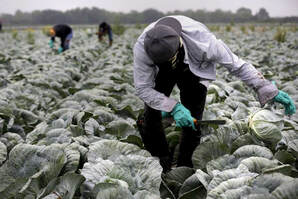
In the predawn light, Francisco Garcia kisses his two daughters and whispers that he'll be back after work. He makes his living harvesting onions near the South Texas town of Mercedes, a few miles from the Mexican border. "For an indocumentado like me, this is how we make a living. For us, there is no coronavirus. My kids and my wife depend on what I bring in every day and that's it," said Garcia, 40. "Why? Because we don't have benefits, nobody's helping us." More than half of the 2.5 million farmworkers in the U.S. are undocumented. But while their presence is considered illegal, their work amid the coronavirus pandemic is far from that - the Department of Homeland Security has deemed farm work an "essential" service. Farmworkers and their advocates are concerned about their working conditions, comparing them to... (read more)
"Exporting the virus": Migrants deported by U.S. make up 20% of Guatemala's coronavirus cases.

When it unveiled an unprecedented order last month to swiftly expel virtually all unauthorized migrants from the U.S. southern border, the Trump administration said potentially infected foreigners could spread the coronavirus in the U.S., prompt outbreaks in immigration jails and strain public health resources along border communities. But in a paradoxical twist, Guatemala, the largest source of migration to the U.S.-Mexico border in recent years, fears the U.S. is exporting the virus there through deportation flights. At least 99 migrants recently deported to Guatemala by the U.S. have tested positive for coronavirus as of Sunday, according to the nation's public health ministry. Deportees from the U.S. make up nearly 20% of the... (read more)
Some border area U.S. citizens will not be getting stimulus checks.

Tom Kobylecky is a truck driver from Chicago. He lives in Reynosa, Tamaulipas, which has been his home for over ten years. Indeed that ten-year period is in itself very significant because he has lived just across the border with his entire family for ten years on the advice of his immigration attorney. After living in Reynosa for ten years, the Kobylecky family were beginning to see light at the end of the tunnel. His Mexican wife was waiting for an appointment at the U.S. Consulate in Ciudad Juarez to apply for legal residency. Then along came the COVID-19 pandemic, and a series of administrative rulings by the Trump administration that have put dark clouds on the horizon. The most recent, a ruling that excludes U.S. citizens married to immigrants without a social security number to receive stimulus checks. "I really haven't been affected too much by COVID-19 other than having to spend... (read more)
Published: April 16, 2020
Coronavirus on the border: Why Mexico has so few cases compared with the U.S.

The U.S.-Mexico border has long been a region of contrasts. But people in both countries are puzzling over the latest one: The number of confirmed cases of the coronavirus on the Mexican side is just a small fraction of the U.S. count. On Sunday, confirmed cases in California topped 6,200, compared with just 23 in Baja California. Arizona had 919 cases, dwarfing the 14 in neighboring Sonora. New Mexico reported 237 cases; in Chihuahua state, there were six. The U.S.-Mexico border is the busiest in the world, with an estimated 1 million legal crossings per day. The neighbors' economies are intertwined. So why is there such a big difference in cases? The disparity reflects, in part, a time lag. Mexico did not report its first case until Feb. 27 - a month after the virus was detected in the United States. To date, the country has counted 993 cases, less than 1 percent of the U.S. total. But Mexico is also pursuing an unorthodox strategy. It is relying less on tests, and more on... (read more)
Scenes from the U.S.-Mexico border during coronavirus pandemic.

Members of an asylum-seeker family remain in a tent at the Juventud 2000 migrant shelter in Tijuana, Baja California State, Mexico, on April 3, 2020 during the novel coronavirus, COVID-19, pandemic. Thousands of migrants overcrowding shelters or begging in the streets in Mexican cities along the US border are living in fear as the novel coronavirus spreads in the population and screening interviews for asylum seekers are being suspended. (Photo by Guillermo ARIAS / AFP). See complete gallery here.
Border families express concern over border COVID-19 restrictions.

Families who are divided by the border tell KTSM they are growing concerned with the spread of COVID-19 after restrictions were put in place two weeks ago at border crossings for essential travel only. "It's all too common, we have a lot of families who have been separated by our immigration laws, where you have family members who have been deported and are living on the Mexican side," said Immigration Lawyer Iliana Holguin. She explained tough situations are being made worse. "It's hard enough being separated from your family members like that during normal times and it's even more difficult when we're talking about the situation that we're in right now," Holguin said. Patricia Miramontes told KTSM it's affecting her now. Two years ago Miramontes husband was deported, now she lives in El Paso while her husband and daughter live in Juárez. "I go to Juarez every weekend, I don't ever miss," said Miramontes. She explained she's lucky she... (read more)
Published on: March 26, 2020
Coronavirus border travel restrictions start to impact daily life.

Mexican residents with legal visas began to be turned away from the U.S. Saturday morning. Martin Arce, a Tijuana factory worker, spent the past week manufacturing respirators that are being shipped throughout the U.S. to fight to coronavirus pandemic. Work was so hectic, that Arce didn't have time to pay his phone bill. Because unlimited plans are cheaper in San Diego than they are in Tijuana, Arce has a plan from Cricket Wireless. And because his phone is now shut off and he doesn't have a computer, Arce has to cross the border to pay his bill in person. But when he tried to cross through the San Ysidro Port of Entry Saturday morning, Arce was turned away because of new restrictions prohibiting "non-essential" cross-border travel. The restrictions, announced Friday by President Donald Trump, went into effect just after midnight Eastern time Saturday - 9 p.m. Friday here. The goal is to stem the spread of the coronavirus by limiting cross-border travel while still protecting trade and commerce. A similar deal is... (read more)
South Texas COVID-19 cases spike on border with Mexico.

Fears the virus will infect a Mexican border tent encampment where thousands of asylum-seekers live. The number of cases of COVID-19 in two South Texas border counties dramatically spiked on Saturday night totaling five cases with the announcement of the first confirmed case in Hidalgo County and several in Cameron County, health officials said. Hidalgo County Judge Richard Cortez on Saturday night announced that a coronavirus case was confirmed in McAllen, which is the largest city in the border county. That triggered the county to order the Hidalgo County Division of Emergency Management to go into a Level 1 Operational status, the county's highest. "We knew this day was coming and we are prepared," Cortez said in a statement. "This is a highly contagious disease and residents should not be surprised - or alarmed - that others in Hidalgo County will likely contract the virus." The news..(read more)
A closed border, dashed hopes and a looming disaster.

The United States, citing the coronavirus, is shutting off access for anyone trying to claim asylum from the Mexican border. Tania Bonilla arrived in this Mexican border city on Wednesday determined to apply for asylum in the United States. With her 1-year-old in tow, she had defied the odds - evading a death sentence by a Honduran gang at home, she said, as well as deportation by the Mexican authorities at the southern border and kidnapping by smugglers en route. But now, in eyeshot of an international bridge connecting the Mexican city of Ciudad Juárez to the United States, a new and even more serious obstacle presented itself: the coronavirus. In response to its rapid spread, which has claimed about 13,000 lives worldwide, the United States government announced on Friday that in addition to closing the Mexican border to nonessential traffic, it would shut off access for anyone trying to claim asylum from the border. In practice, the United States will deport anyone caught crossing between official ports of entry, including.. (read more)









